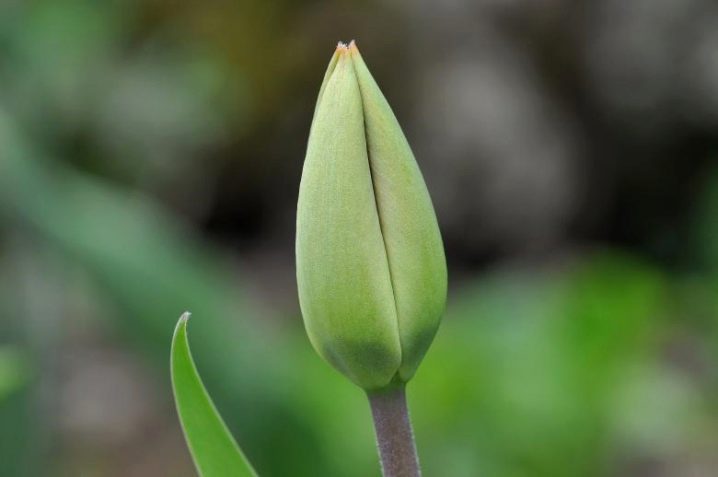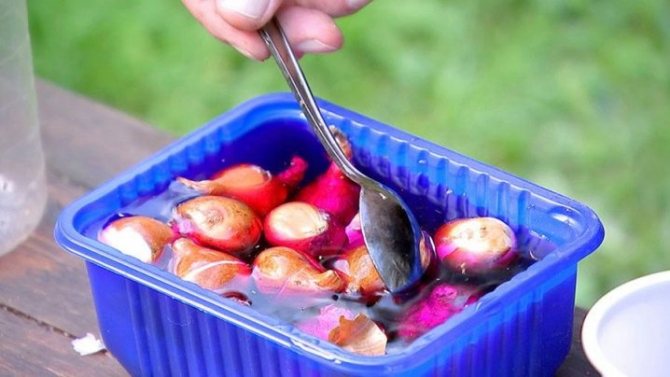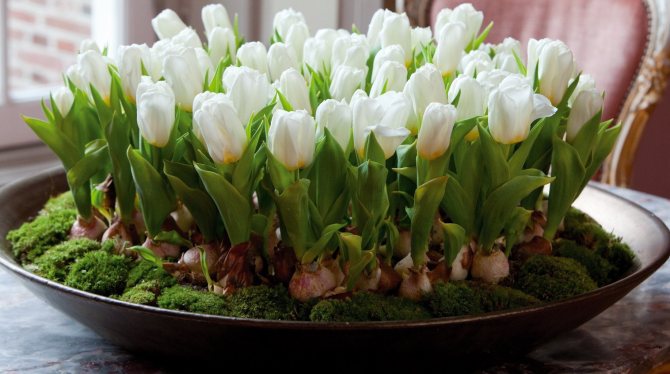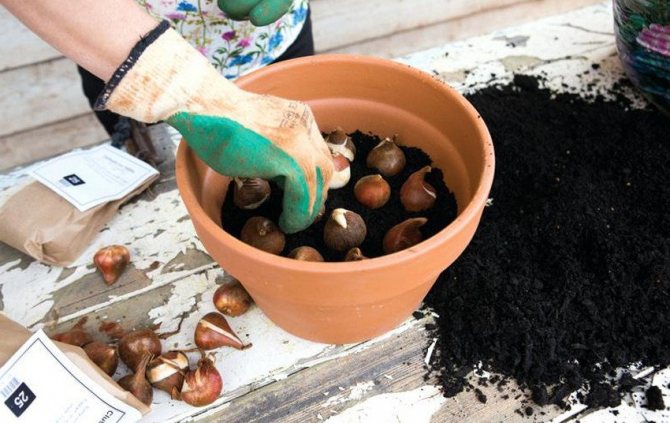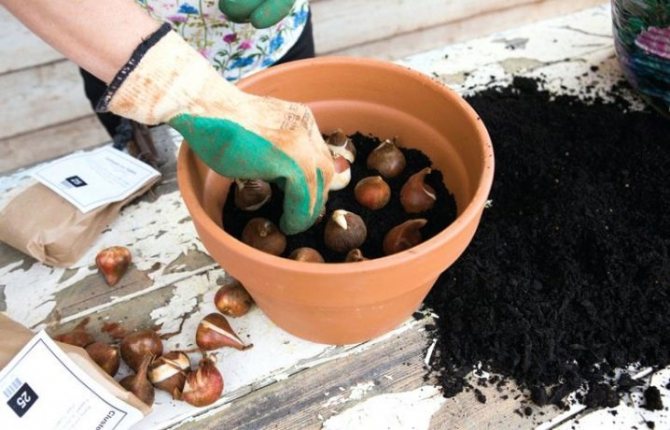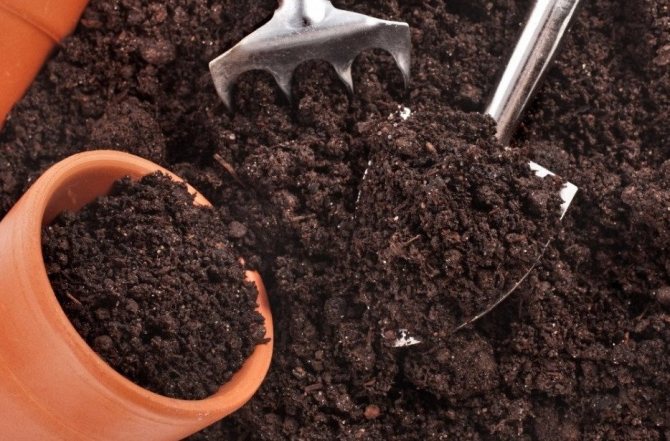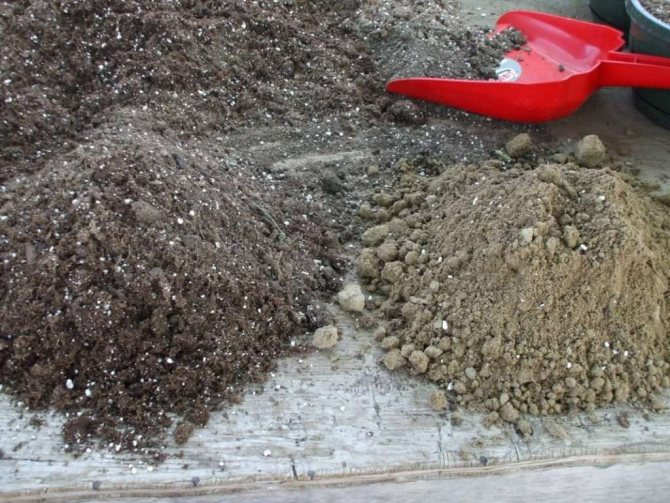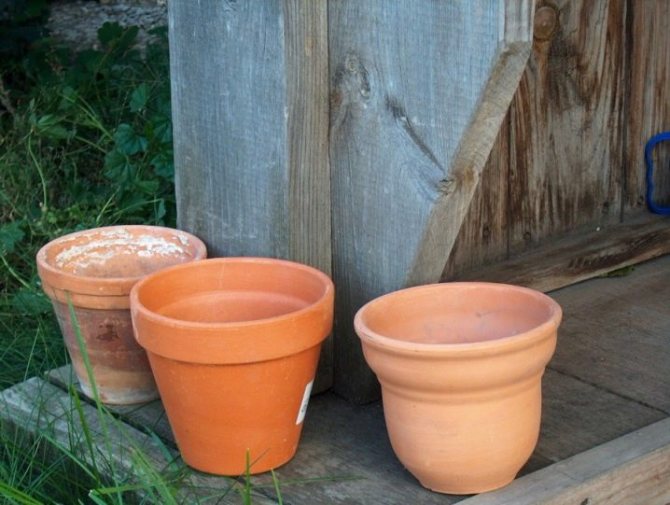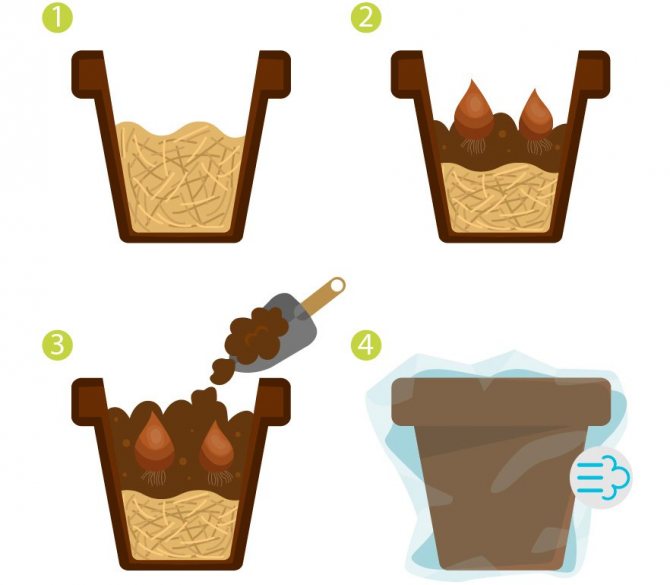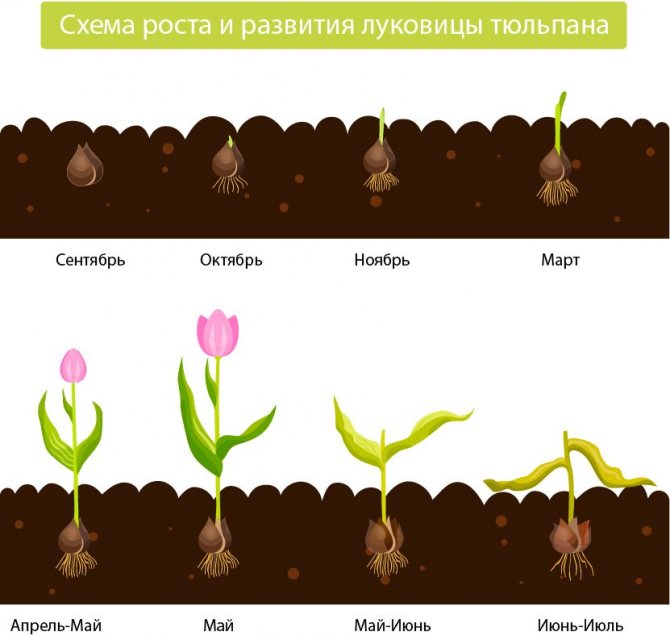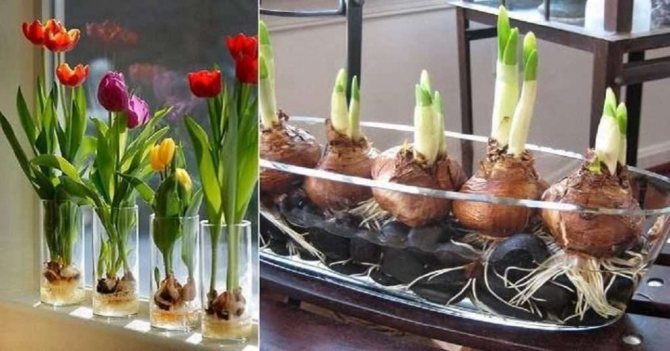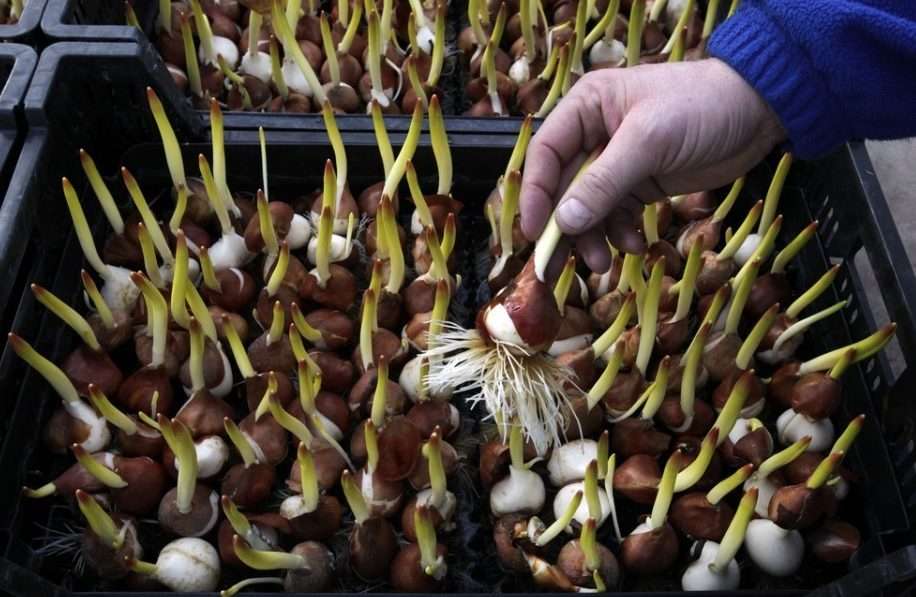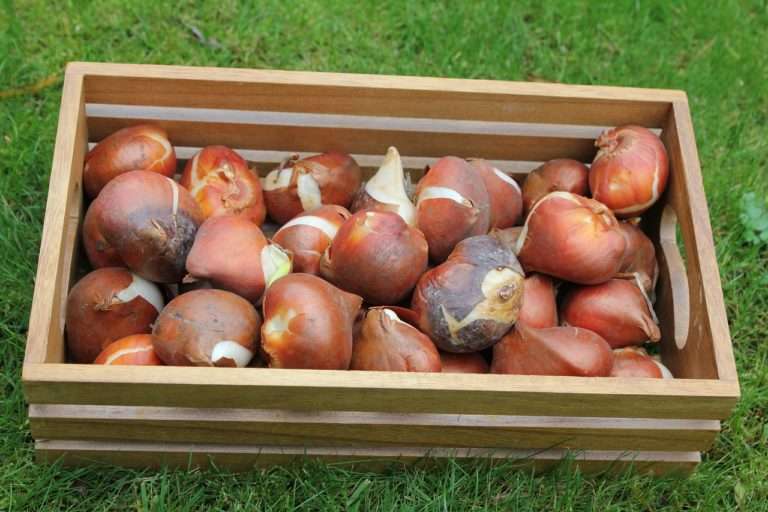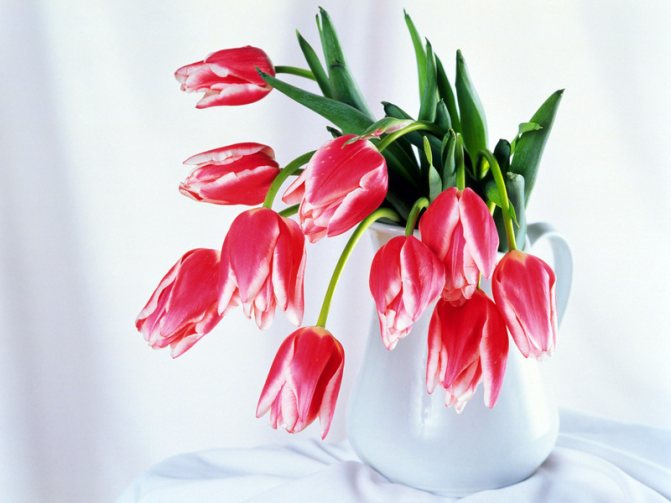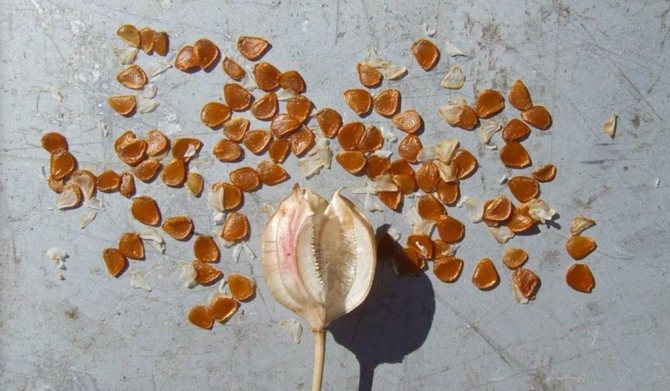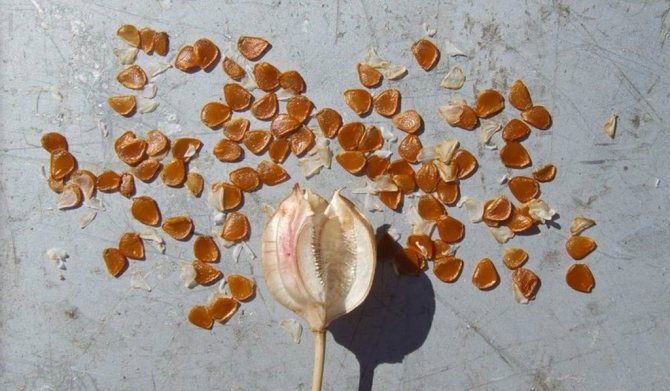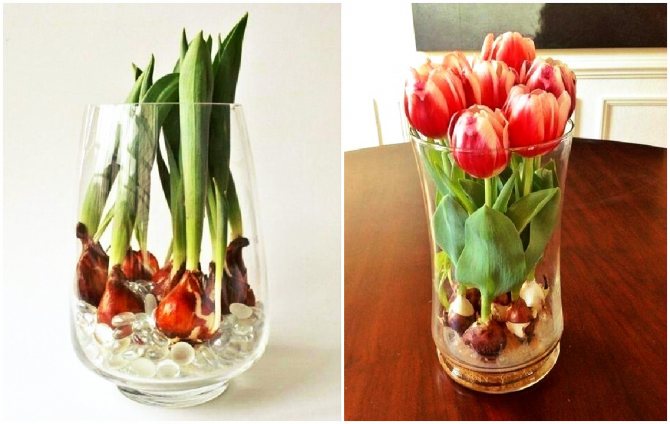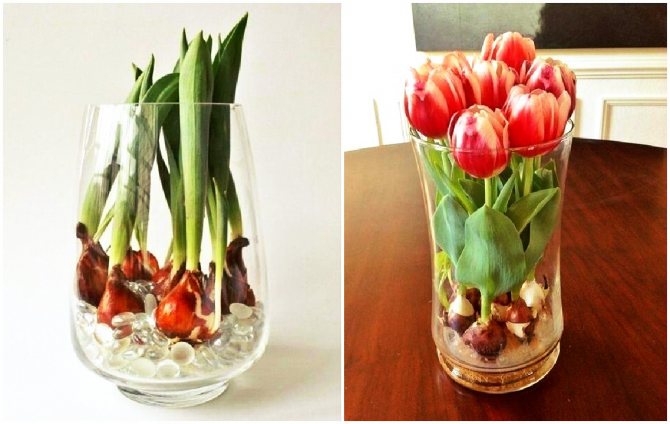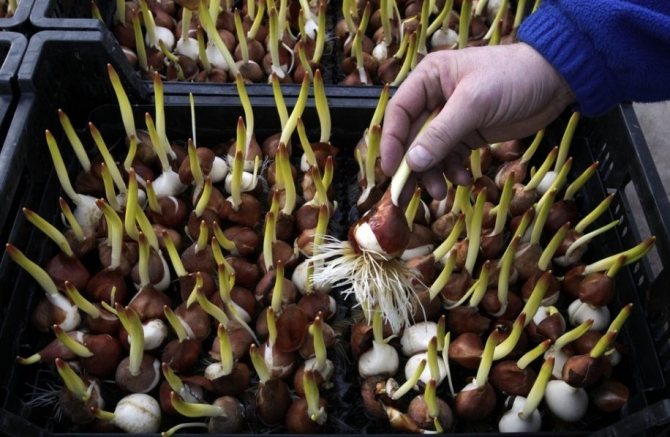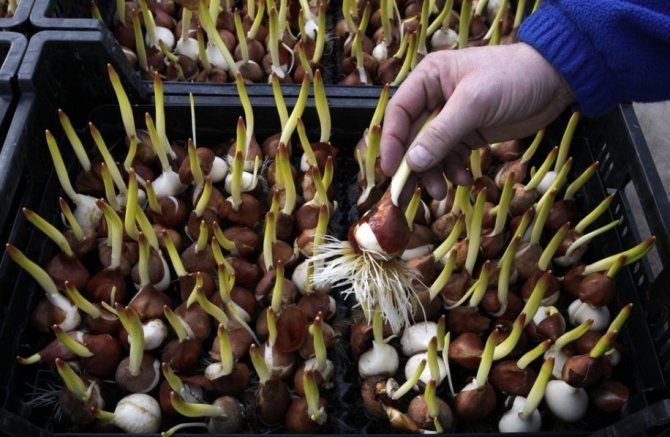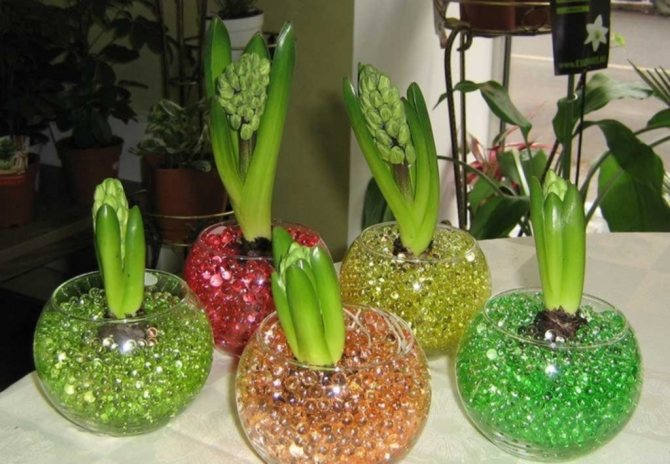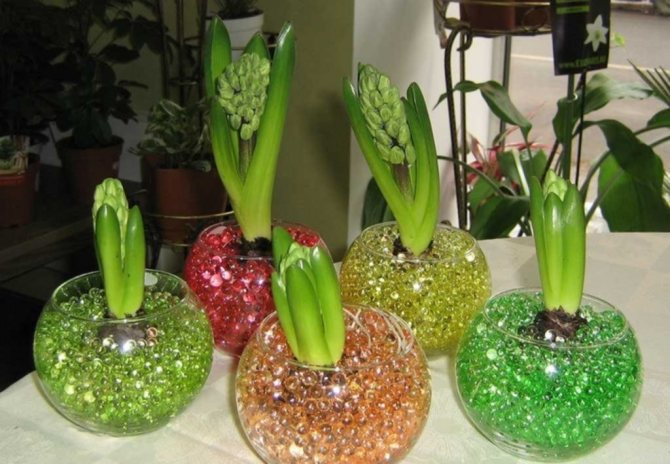
Imagine how surprised your guests will be to see that you are growing tulips at home! Spring-like green stems with exquisite buds of a wide variety of colors look unusually impressive against the background of white snow outside the window. Delicate bulbous flowers grown on the windowsill will not only become your pride, but also brighten up the long wait for spring.
Is it possible to plant and grow tulips on the window of an apartment in a pot?
It is possible to create conditions for growing tulips in a city apartment, since these flowers are not too demanding to light and grow well under artificial conditions.
The temperature regime for the germination of the heads on the window can also be maintained at home. The main thing is to choose the right varieties for growing, because the decorativeness of flowering will depend on this.
The following varieties of tulips lend themselves to forcing:
- early, low and medium-sized with a simple flower shape or double;
- tulips of the "Triumph" class, early flowering with large flowers and a stem length of up to 0.7 m (forcing of these tulips is the most preferable);
- Plants of the Kaufman and Foster varieties, low, double petal, bicolor.
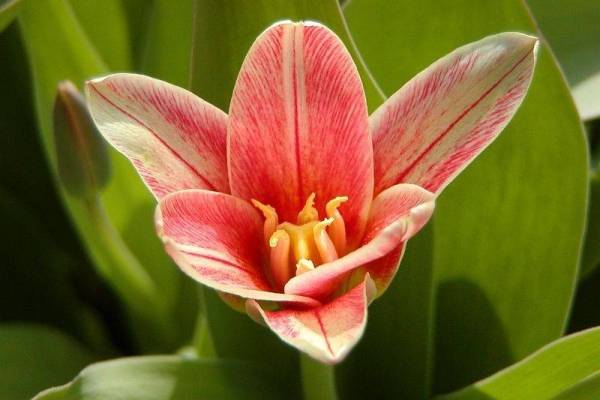

Tulip varieties can be distilled: Kaufman and Foster, class "Triumph", early, low and medium-sized
When planting bulbs, you need to decide on the timing of flowering, because forcing is divided by flowering time into:
- early - flowering period in winter, by New Year and Christmas (planted in pots in early autumn);
- average - flowering throughout January and by Valentine's Day (planting in October);
- late - receiving flowers by March 8 (planting at the end of October - November).
Having decided on the varieties of tulips, you need to take care of purchasing planting material. Many foreign firms sell bulbs specially prepared for distillation (forcing varieties), this is stated on the packaging.
During, when the tulip buds start to gain color (the edges of the green petals change color to pink, white, yellow, etc.) they are cut... All the forces of the flower then go to the development of the underground part of the plant.
After the leaves turn yellow, the onions are dug, dried at room temperature for 2 weeks, and then placed on the bottom shelf of the refrigerator until disembarkation.
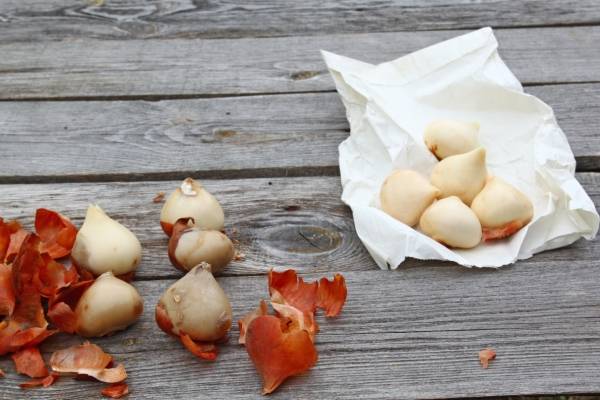

When the tulip buds begin to gain color, they are cut off, the bulbs are dug up and placed on the bottom shelf of the refrigerator.
Tulip varieties for home cultivation
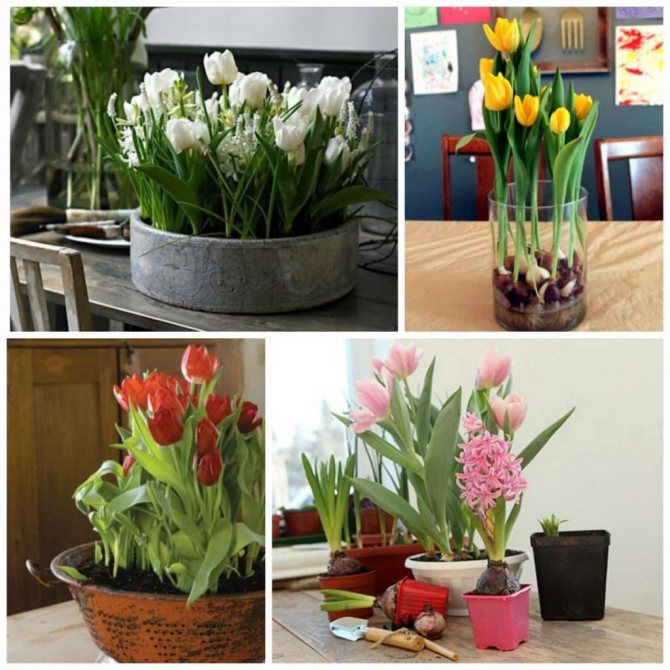

Growing capricious exotic varieties of blue, brown, purple and black colors in a pot is troublesome. But if you are dealing with proven, unpretentious low-rise varieties and hybrids, then you can grow species that are resistant to diseases and such a problem as variegation.
Purchased bulbs are unpretentious in terms of keeping and tolerate disturbances during cultivation. They can be planted immediately after purchase as they have already been sorted and processed.
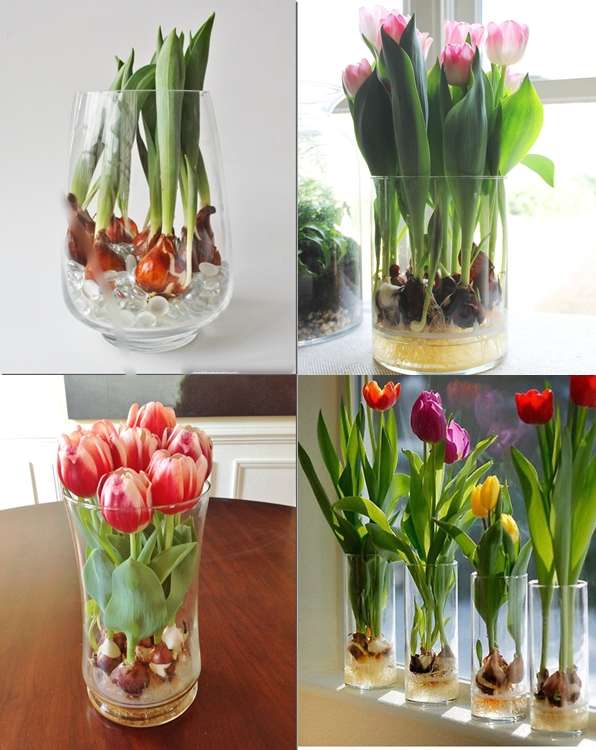

Is it possible to grow tulips at home in a pot directly from the garden? If you want to prepare planting bulbs from those varieties that are already growing in the beds, then you cannot do without careful care during the growing season: watering, feeding, loosening the earth and destroying weeds. Only when the stems turn yellow can you dig up and plant tulips at home in pots, those. bulbs of varieties: Aristocrat, Apeldoorn, Brilliant Star, Diplomat, Parade Record, Christmas Marvel, Confux, Lustigue Battle, London, Bridge Miles, Negrita, Oxford, Parade, Scarborough, Temple of Beauty, Fringit Elegance, Eric Hofcier and Epricot Beauty.
Conditions for growing a house on a windowsill
To successfully grow tulips at home, certain conditions must be met.
Illumination - affects the quality of colors. The duration of daylight hours should be at least 10-12 hours. In January and February, the daylight hours are 7.5-9 hours.
Temperature... The ideal temperature to grow bulbs is 12-18 ° C.
When the temperature drops by 2.5 degrees during the day, the beginning of flowering is delayed by one day, and an increase in temperature to 20 degrees, on the contrary, brings flowering closer by 2-3 days.
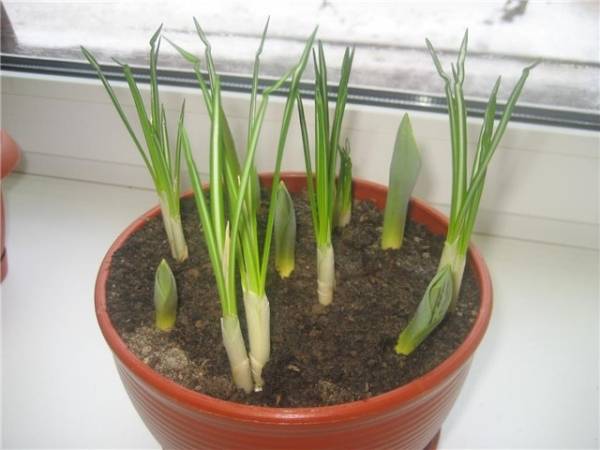

Growing conditions: illumination for at least 10-12 hours and a temperature of 12-18 degrees
Sorting and selection of planting material for storage
In the replacement bulb, the scales are always light brown. According to their sizes and grades, they should be laid out in several layers in boxes made of metal or plastic mesh and kept for 2 days on an open balcony or in the yard. Those nests that consist of several well-divided bulbs, detach, rinse with water under the tap and soak in 0.5% potassium permanganate for half an hour to destroy fungi, viruses and pests. Then put it back into boxes, but in one layer to dry for 3-4 weeks at a temperature of 23-25 ° C heat and good air exchange (ventilation). From the beginning to the end of August, the storage temperature should be - 20 °From heat, and in September before landing in the ground - 16-17 ° С.
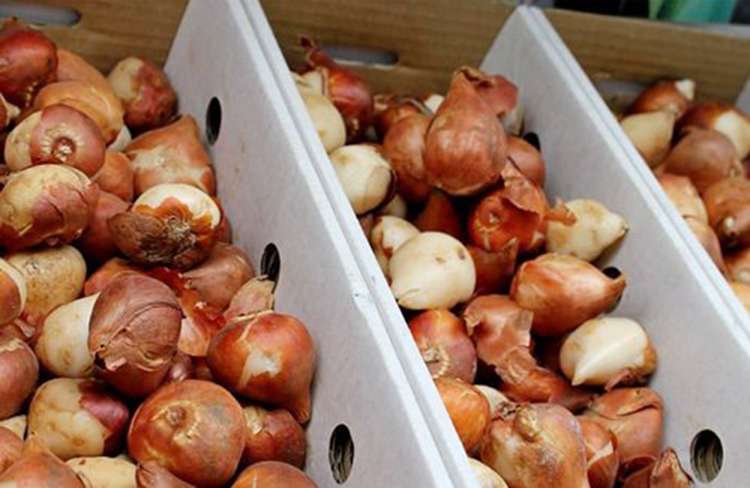

It's important to know. This temperature regime is necessary for the formation of daughter ovaries in the replacement bulb. When storing planting material in the refrigerator at a temperature of 5-8 °With the heat, the temperature regime will be violated, and tulips will be thrown away instead of flowering buds - "blind".
Selection of bulbs for planting
For planting for distillation, only very large specimens, dense, heavy and, most importantly, absolutely healthy.
The bulbs must be 10/11 (first cut) or 12/12 + (extra size), the numbers on the package indicate a circumference of 10-12 mm, the diameter is 35-40 mm.
Heads must be heavy in weight, their weight is not allowed less than 25 grams (lower weight indicates that there is no flower bud in it). The larger the bulb, the more powerful the plant will be and the larger the flower.
Choosing a place and preparing a bed
The successful location of the garden and the planting of tulips in the fall when and how to plant the choice will be less problematic. These flowers love sunny, sheltered spaces. There should be no puddles in the spring. The soil must be well drained - loamy or sandy loam soil with a significant amount of humus would be the best option.
It is worth digging the ground to a depth of 25-30 cm, carefully removing the roots of weeds, trees and shrubs. If the soil is heavy and poor, add sand and fertilizers: compost, ash, peat, mineral complexes. You cannot use cow dung - add bird droppings instead. If the PH values are increased towards oxidation, liming is required.
You need to prepare the land a month before the expected date of planting. This is necessary for the soil to “settle down”. In a loose "pillow" there is a high probability of damaging the roots that have appeared. Before direct planting, pour abundantly on the ridges - this will finally distribute the earth.
Usually, this is where the care of tulips after planting ends in autumn.It is not necessary to cover the garden bed - this can lead to the fact that the bulb will grow ahead of time, it will winter worse and will bloom later. Exceptions are sudden cold weather. When the temperature drops sharply, use a specialized covering material. Do not use garden debris, mulch or leaves for this - this can attract rodents.
How to plant a flower correctly
Before planting, the onions must be cleaned of the brown shell covering them., due to which its suitability for planting is determined (no damage and disease), as well as a larger amount of nutrients and moisture enters the peeled bulb, the roots penetrate into the soil faster.
Then it is necessary to decontaminate the heads... They are placed for 30 minutes in a strong solution of potassium permanganate, or etched in preparations Maxim, Fundazol.
For planting tulips, pots or containers filled with 2/3 light nutritious soil with the addition of sand and humus are used.
Bulbs are placed at a distance of 2-3 cm from each other., slightly pressing them into the pre-moistened soil (to disinfect the soil, it can be spilled with a pink solution of manganese), sprinkle on top with a layer of sand and earth.
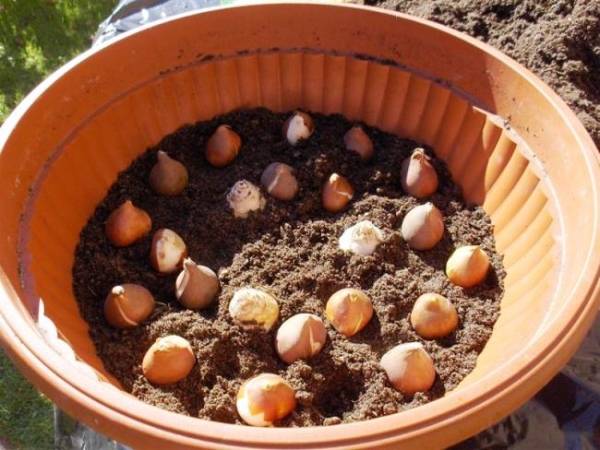

At a distance of 2-3 cm from each other, the bulbs are placed, slightly pressing them into the pre-moistened soil, sprinkled on top with a layer of sand and earth
Bulbs must be completely undergroundif after watering they become bare, they are again covered with earth.
Unlike open ground, forcing onions are not deepened to a height of up to 3 bulb diameters.
Planting containers with bulbs to maintain moisture placed in plastic bags and sent for cooling in a cool place, basement or refrigerator.
3-4 weeks before the selected flowering time, containers with tulips are brought into the room and gradually begin to get used to lighting.
For the first 3 days, it is desirable that the air temperature does not exceed + 15 ° C and the lighting is not too bright (exclude direct sunlight). It is best to darken the sprouts by covering them with agrofibre or a double piece of gauze.
Then we increase the temperature to 18 ° C and put it on a well-lit windowsill. In order for the heat from the radiators to have less effect on the temperature on the windowsill, the plants are fenced off in height from the radiator with a substrate under the laminate.
On a cool windowsill, tulips will bloom for a long time, and on hot buds from dry air can dry out. To prevent tulips from stretching too much when there is a lack of lighting, they are highlighted.
To accelerate the flowering process of tulips, use:
- soaking the heads in a gibberellin solution for 48 hours;
- watering tulip sprouts with a solution of gibberellin, three times before flowering, which, in addition to accelerating the onset of flowering, also contributes to an increase in buds.
Forcing tulips at home:
Plant formation
Growing a flower at home depends entirely on the choice of variety and planting material. You can buy bulbs in a specialized store or grow them yourself.
The planting material is stored in a special way: for this, after digging out the bulbs, they should be dried for 7 days at a temperature of more than 30 degrees, the next 60 days they are stored at room temperature, then they are removed in a cool place, placed in boxes, and stored in the refrigerator.
After planting, the bulbs are recommended to be watered every three days so that it does not dry out. As soon as the plant has released the first flowers, it is rearranged on the windowsill so that the tulip delights with its appearance longer.
Flowers must be sprayed with a spray bottle. Plants do not like low air humidity, so when watering, you should make sure that moisture does not get on the flower, otherwise it will begin to wither.
How to grow: home care rules in autumn and winter
Further care of the plants consists in watering and feeding.
Watering should be regular, the soil should not dry out and it is better to water from a spray bottle so that the water is evenly distributed and does not clog the soil.
It is advisable to take water separated or passed through a filter in order to reduce the amount of salts in it. The best watering option is melt water.
In the first ten days, watering is alternated with top dressing. 0.2% calcium nitrate solution, which promotes the growth of strong stems.
When applying fertilizers, the dosage must be strictly observedso as not to overfeed the plants and cause burns. Overfeeding bulbous plants can lead to a lack of flowering.


Watering should be regular, the soil should not dry out, watering alternates with top dressing
If you want to preserve the bulbs after flowering, then after cutting the flowers, we continue caring for the tulips as in the open field. We carry out watering, feeding, so that the bulb recovers and accumulates nutrients.
After the foliage turns yellow, we dig out the tulips, dry them and leave them in a dark, dry place until autumn.
There are no particular difficulties in planting and growing tulips at home. The main thing, correctly determine the timing of planting and planting material, adhere to the basic rules of cultivation.
And having planted the bulbs, we, like children, will live in anticipation of the miracle of flowering.
Choosing tulip pots
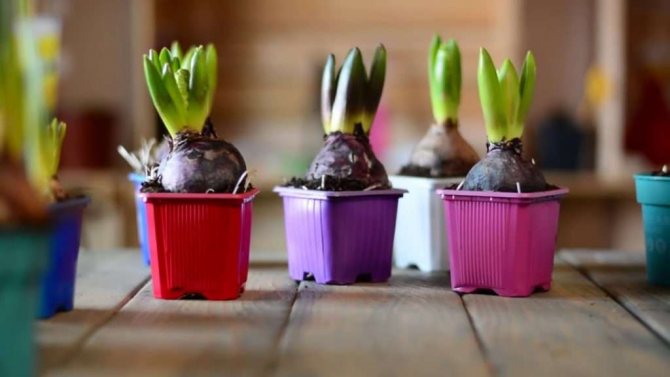

Tulips feel comfortable in pots or bowls of clay or ceramic with drainage holes. But many use cheaper plastic or terracotta pots, or just wooden boxes. Thanks to the high-quality natural material of the containers, air exchange takes place, which is important for the root system and the bulb. Excess moisture will come out through the drainage holes, then the roots and body of the bulbs will not rot. It is recommended to choose containers with a diameter of 22 cm or more and a depth of 15-45 cm.
reference... A pot up to 22 cm in diameter accommodates 2-9 large and medium bulbs up to 4-6 cm in diameter, and up to 55 cm - 25 medium tulip bulbs. A pot 15 cm high and up to 20 cm in diameter can hold 1-3-5 bulbs up to 3.5 cm in diameter. A pot up to 15 cm will fit 3 bulbs up to 3 cm. In this case, each onion is removed from the other and from the wall of the pot by 1.5-2 cm.
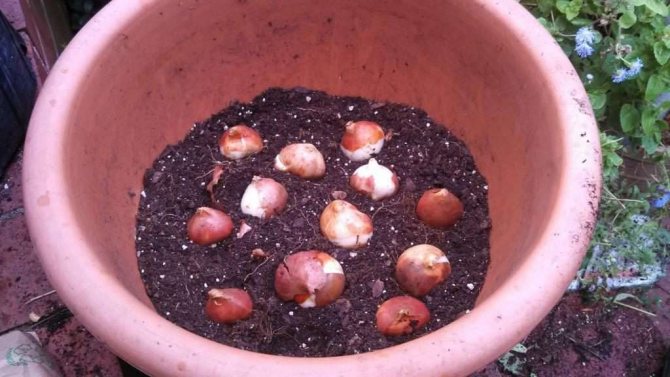

Depending on the flowering time of the buds, tulips are planted in pots in autumn, starting from the first days of September and ending at the end of October. First, the planting material is placed against the wall of the container and then advanced to its center.
The bulbs should be deeply and firmly pressed in (but not screwed in!) With a flat base, while the point is directed upwards. You don't have to press too much in order not to create competition between them for food and water. Otherwise, you will need to carry out regular watering and feeding.
Planting tulips at home
First of all, you need to prepare pots for tulips. They should not be too small, especially if you plan to plant several bulbs at once. It is better to choose medium sized pots. Do not use high and deep containers, because there is no point in this - tulips have a small root system.
In the next step, the soil is prepared. Pure peat or mixed with a small amount of sand can act as a soil for planting tulip bulbs. Perlite or garden soil can also be used. In addition, you will need to add 1 part of compost or manure and a small amount of wood ash to the pot. All these components are thoroughly mixed and slightly moistened.
Now you can proceed to planting the bulbs. They should protrude 1/3 above the soil. The bulbs should be planted at a short distance from each other - about 1 cm. Then they are watered abundantly.It is better to use a special solution here so that the tulips begin to grow actively as soon as possible. Take 10 grams of 0.2% calcium nitrate per 5 liters of water. If, after watering, it is noticed that the soil has strongly settled, then it must be filled up in a small amount so that the bulbs are 2/3 in the ground. Then the pots must be taken to a basement or other room where the air temperature is no more than 10 ° C. When the bulbs sprout 5 cm high, they will need to be placed on the windowsills so that they can begin to receive sunlight.
Growing tulips for the spring holiday
You can grow tulips at home directly on Valentine's Day (February 14) and on March 8 for your beloved women.
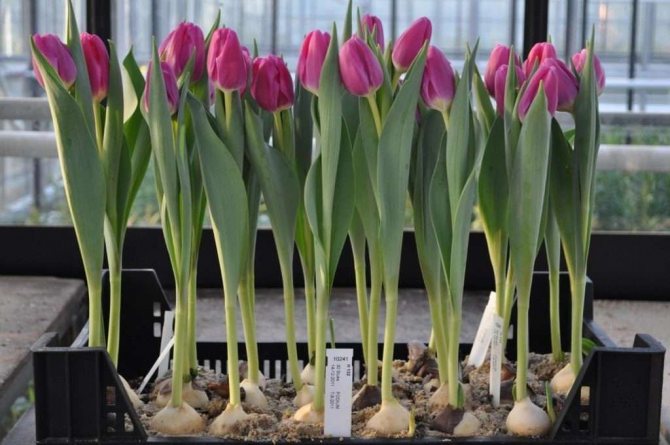

Planting is carried out from the first days of October to mid-December in accordance with our recommendations:
- In pots with a diameter of 20-22 cm and a height of 15-20 cm, lay out a layer of drainage to a height of 3-5 cm to cover the drainage holes so that the irrigation water does not wash out the soil.
- Pour soil on top of the drainage to a height of 8-10 cm and press into it 5 round-shaped bulbs up to 4-6 cm in diameter, first remove the husks from them, especially near the roots. Maintain the distance between them and the wall of the container - 2 cm. Turn their flat sides to the wall so that the tulip leaves bend outward during growth. Press in to a depth of 1 cm without twisting.
- Cover the seedlings with earth to the sharp tops, which remain above the surface at a height of up to 0.5 cm.
- Moisten the ground well and cover the planting with a dark plastic wrap to slowly dry the moisture.
- Place the pots during the dormant period of seedlings in a dark room for 40 days at a temperature of 8-10 ° C. Remove the film for 15-20 minutes daily for airing. In this case, you do not need to turn on a bright light or take out containers from a dark room. The dried earth is slightly moistened.
- When shoots appear to a height of 5-7 cm, take boxes or pots into a lighted and warm room with an air temperature of 18-20 ° C. You can arrange them on the windowsills of western or eastern windows without central heating or the proximity of other heating devices and create diffused lighting, without the bright direct rays of the sun.
- In order to prevent decay of the planting material, it should be watered periodically when the topsoil dries up in small portions of water.
Helpful information. In order for tulips to have different heights, and there are more of them, the bulbs can be planted in two layers.


To do this, sprinkle soil 2.5-5 cm thick on the bottom layer of the bulbs and press the second layer of seedlings into it, then cover it with earth to the sharp tops, as indicated above. Tulips will bloom and fill the entire container. You can fill the top layer with soil to a height of 15-20 cm, and press the second layer of seedlings above it.
Home tulip care
In order for as many buds as possible to bloom in winter, you need to take special care of them. It is important to water the tulips several times a week and to prevent the soil from getting dry. Plants are fed twice a month. Here you need to use special formulations that are sold in flower shops. They are divorced according to the instructions.
When the buds are blooming, make sure they don't start to fade ahead of time. To do this, you need to rearrange the pots in a place where strong streams of hot air are not observed, that is, they should not bloom next to batteries or heaters.
When to plant
The soil temperature affects the planting time. In the fall, a reserve is made for subsequent flowering, so it is important to plant the bulbs in the garden in time. In order for all processes to start, the soil must be no colder than 10 ° (the lower value of the border is 8 °). You can check the data using a depth thermometer.
In different regions, the timing of planting in open ground is different.So, the planting of tulips in the fall in the Moscow region takes place from mid-September and throughout October. The hotter the region, the closer to winter the dates are shifted. If, during the pre-planting inspection, you notice that the bulb is ready to actively start growing, it makes sense to leave it for distillation (i.e., plant it in a pot and keep it at home).
In other regions, which are distinguished by more severe climatic conditions, the landing period falls on the end of September to mid-October. If the autumn is hot, then they are planted until the beginning of November. For example, the optimal planting of tulips in autumn in Siberia falls on October 10-20.
Video "Planting tulips in the fall"
Tulips are the most beautiful flowers, a real decoration of the spring garden. Planting tulip bulbs in autumn is the best solution for early flowering. They do not require complex care and special skills, so everyone can try to master an unknown flower.
In order for tulips not to lose their decorative effect, the bulbs are dug out after flowering, and planted again in the fall. This approach not only allows you to preserve the health of plants, but also to timely separate the formed babies from the mother's bulbs and then use them for reproduction. The procedure must be carried out in the correct time frame and in full compliance with the technology. These nuances are very important when planting tulips.
Proper storage and preparation for planting
After the bulbs are dug, that is, during the storage period, the tulips have completed the formation of all the elements of the future flower and peduncle. Therefore, by adjusting the temperature, it is possible to accelerate or delay the development of flower rudiments and thereby change the timing of flowering.
But main requirement - it should be large, that is, in a circle of at least 12 cm, with a diameter of 3.5-4 cm. Usually the weight of such a bulb is 30-40 g. Such giants are formed if you grow flowers according to all the rules: watering, feeding, digging up in time, carefully store and return to the flower garden not earlier and not later than the optimal time.
If you are not sure that your tulips will meet these requirements, you can do an easier thing - buy forcing bulbs. A little later, we will tell you which ones are best for winter or early spring flowering.
Autumn terms of planting tulips in open ground
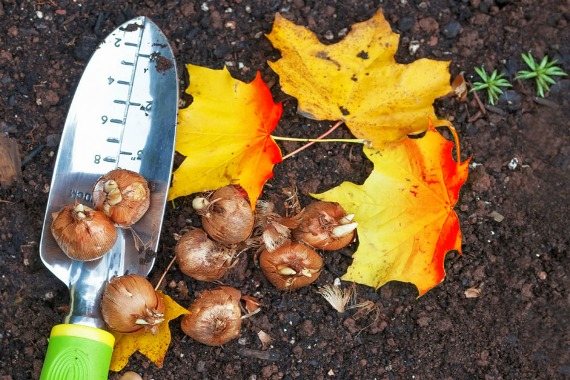

Tulip bulbs can be planted in fall and spring, but fall planting is preferred. If you postpone it until the spring period, flowering in plants will be weak or not at all. In addition, the cold period in winter (stratification) is necessary for the full development of the bulb and is part of the tulip's life cycle.
Only when grown this way do the bulbs have a chance to form large and healthy bulbs. The planting time is important because tulips planted too early can start growing and the sprouted shoots will be killed by the frost that has come, and if you are late with planting, the bulbs will not have time to take root and flowering will be delayed in spring.
When to plant tulips in the regions, in what month
The weather conditions in the regions vary significantly. From this, and you need to build on, being determined with the date of planting tulips. Each locality has its own date for this procedure:
- In outskirts of Moscow the bulbs are planted in the ground starting at the end of September. You will need to complete the landing by mid-October. The coming night frosts will not interfere with the rooting process. By the time the snow falls, the tulips will be completely ready for wintering.
- Siberia characterized by short summers, severe winters and early autumn. To give tulips time to root, it is better to plant them in the last days of August. With a favorable weather forecast, the dates can be shifted by 1-2 weeks ahead.
- Ural the ridge is long, therefore the climate in different parts of the Urals has great differences.In the South Urals, planting in terms of timing is equated to the Moscow region, tulips can be planted until the 2nd decade of October. For the Middle Urals, the optimal landing time will be from August 20 to September 20. In the Northern Urals, planting should be completed by mid-September.
Be sure to make allowances for the specifics of the current season. Punctual gardeners keep a weather calendar, annually entering data on temperature changes. This measure allows you to more accurately navigate the climatic features of your area.
Planting tulips in 2019 according to the lunar calendar


For summer residents it has long been no secret that by adhering to the recommendations of the Lunar calendar, you can improve the quality of the harvest and flowering of cultivated plants. In each month, astrologers identify favorable and unfavorable days for planting various cultures.
Temperature regime
The main condition for the successful distillation of flowering from the bulbs is the correct temperature selection. It should be similar to the temperature of the soil in the garden before the tulip begins to bloom.
The first stage, when the formation of all the flower organs in the bulb is completed, requires an increased temperature, at 17-20 degrees, the process takes about 30 days. At lower temperatures, a week longer. The dug out bulbs are placed in gauze bags with labels and stored indoors.
The second stage, the most important, is the cold storage of the bulbs.
Under the influence of low positive temperatures, physiologically active substances are formed in plants, which ensure the growth of a flowering shoot. The duration of the cold period in tulips, depending on the variety, is 12-22 weeks.
In addition to tulips, daffodils and hyacinths can also be grown on the window. They are no less beautiful and will bring a variety of colors.
If the cooling period is too short, the plant develops very short stems and the flower hides in the leaves. During the cold processing period, the bulbs can be stored in the refrigerator... Since they are there for a long time, it is necessary to systematically review them, and remove the diseased.
5 weeks before the desired flowering time, the bulbs are planted in the potting soil. Pre-disinfect bowls, pots or boxes, as well as the soil mixture, rinsing and spilling with a dark pink solution of potassium permanganate. The containers are filled in such a way that from soil level to the edges it is not less than 1 cm.
Digging and storing bulbs
Tulips are dug up annually. Exceptions are baby bulbs, which remain in the ground for 2 years. What is it for: sick specimens are rejected, the appearance is improved (enlargement of flowers), the ability to give children increases.
There are a number of rules for when and how the digging is done:
- Do not miss the moment: you need to dig out tulips when the leaf is 2/3 dry. If you get the bulb earlier, then it will not have time to collect the necessary supply for subsequent flowering. Late extraction is fraught with the fact that the mother's part will go deeper underground, and the babies will separate from it. There is a high probability of missing or damaging the planting material.
- Arm yourself with a bayonet shovel: you must stick it deeply and with a "margin" around the edges so as not to damage the flowers.
- Change the bed every 3 years.
Now more about how to store tulips before planting in the fall. The resulting nests must be divided, freed from husks, roots, and remnants of leaves. Then they are washed (if necessary), antifungal treatment is carried out and dried. Before laying the planting material in boxes, it is necessary to sort it by grades and by sorting. Remove diseased specimens.
Successful planting of tulips in the fall in the ground depends on adherence to temperature and humidity. The bulbs are stored in boxes without a lid, placing them in 2-3 layers. They need to be inspected periodically to remove decaying specimens.The storage temperature is gradually reduced: in July it is 23-25 °, in August - 20 °, in September - 17 °. Failure to comply with the temperature limits leads to the appearance of blind shoots, on which a flower does not form.
If during the inspection you find rot or mold, then you can try to save the tulips. If mildew is not widespread, remove it with a dry cloth and sprinkle with ashes. If the decay has gone deep, cut off the affected part with a knife. Sprinkle the cut with ash or brush with brilliant green.
Video "How to dig up and store tulips after flowering"
Planting tulip bulbs
Before planting, tulip bulbs, taken out of a cold place, should be kept in a solution of sodium humate (0.2%) or heteroauxin (0.5 tablets per 2 liters of water) or simply in a dark pink solution of potassium permanganate, immersed for 30 minutes.
The bulbs are planted close to each other. After watering, their tops should protrude slightly from the substrate. The planted bulbs are placed in a dark, cool room with a temperature 8-12 degrees.
If the coolest place is on the windowsill, the forcing bulbs can be kept there by covering the top with paper and making sure the ground is moist. When the sprouts reach 10-12 cm, the paper is removed.
After 2 weeks, as long as the rooting period lasts, forcing is transferred to the lightest windowsill. Flowering is regulated by temperature, the higher it is, the sooner flowering occurs.
If it is cool on the windowsill, the flowering will be more beautiful and last longer, or, on the contrary, due to too high temperature and very dry air. buds may dry out... Undesirable when flowering and drafts, sharp fluctuations in temperature.
If you wish to save the bulbs for later use after flowering watering continuesuntil the leaves turn yellow. Then they are also stored in a container until September planting in a well-ventilated room at a temperature of 17 degrees and an air humidity of 60-70 percent.
They will be ready for re-distillation. not earlier than in a couple of years.
Care after planting tulips
For life, the plants are periodically moistened, but the soil is not poured when the layer dries to a depth of 2-3 cm.If in the summer the pots are on open balconies or near the house, then they are watered in the absence of precipitation for a week.
In lighted places, tulips can stay up to 6 hours a day, but not in direct sunlight on a sultry afternoon. They should be shadowed by a wall, canopy, or other plants. In order not to increase the temperature of the soil, tulips are planted in light-colored pots. Dark containers are capable of absorbing sunlight.
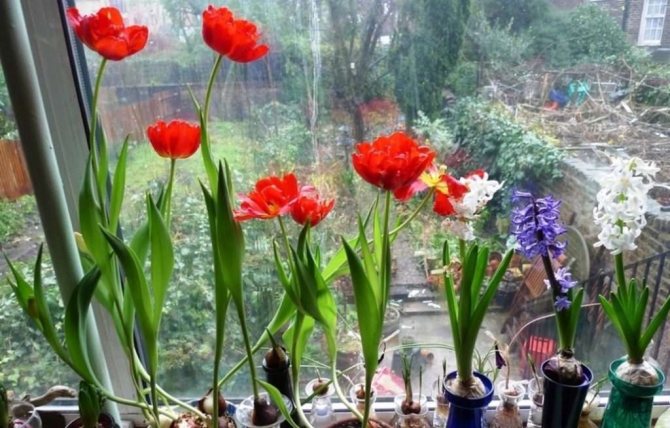

You constantly need to clean the containers of fallen petals and leaves. When the plants turn yellow, they are cut off to protect the bulbs from rotting and more active flowering in the next season. When brown or yellow spots appear on the plant, it is possible to suspect the development of diseases or damage to them by pests, for example, nematodes. So that other tulips do not get sick, they dig out the bulbs of the sick and throw them away.
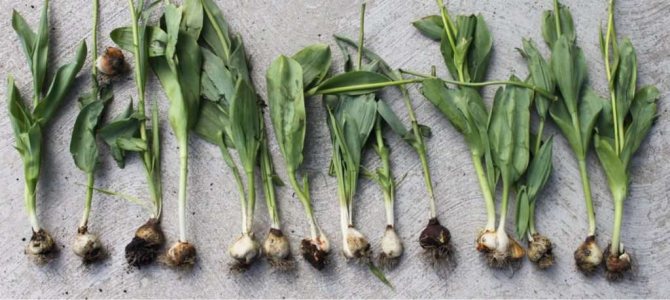

It is necessary to fight gray rot, root rot and typhulosis (fungus). Initially, bulbs with white fungal deposits are not planted. Care should be taken to prevent pets or squirrels in the yard from damaging the tulips. Usually they are covered with a wire frame or fenced off.
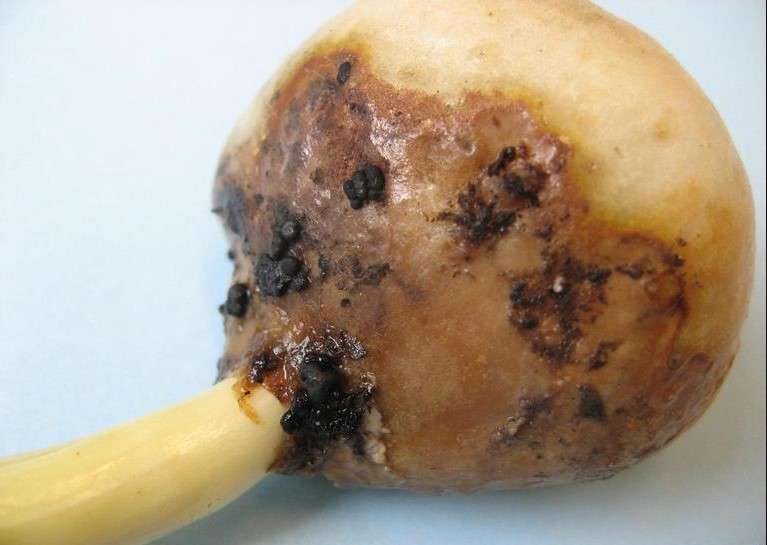

When the first frost appears at night, the flower pots are brought into the room. At zero soil temperatures, potted plants will die. The potted soil should be changed annually. To do this, using a scoop, the bulbs are carefully dug up, then stored, as indicated above, in a dark and cool room. The new land is enriched with nutrients.
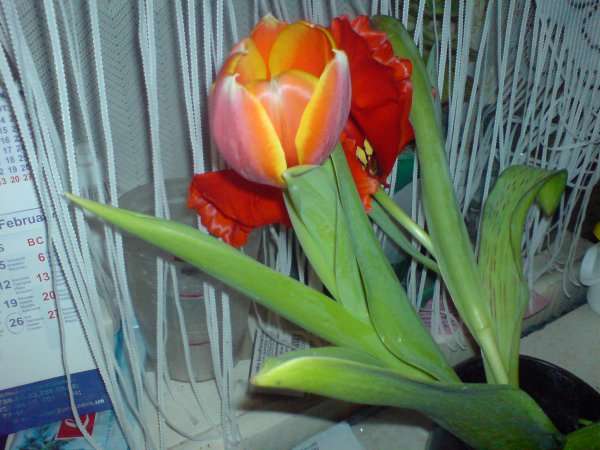

If there is no new soil for annual replacement, then initially you need to put a high-quality soil mixture with compost and fertilizers in the pot, and also sprinkle the soil in the pot with compost before growing.
Imagine how surprised your guests will be to see that you are growing tulips at home! Spring-like green stems with exquisite buds of a wide variety of colors look extraordinarily impressive against the background of white snow outside the window. Delicate bulbous flowers grown on the windowsill will not only become your pride, but also brighten up the long wait for spring.
Flowering on schedule
The most difficult forcing tulips is early, by New Year or Christmas.
Not all tulip varieties are suitable for her. Only those that require a short cooling period can be used.
No more than 15 weeks is needed to cool the bulbs in varieties:
- Epricot Beauty - salmon pink,
- Kritmas Marvel - cherry pink
- Dix Favorite - dark red.
For early distillation, the bulbs are dug up a week earlier than usual. After cleaning, the largest ones are selected and dried at a temperature of 24-25 degrees for two weeks.
Later warm up:
- 4 days at 30 degrees,
- 25 days at 18-20
- 15 days at 17 degrees.
Then the bulbs are placed in paper bags and from September 1 to October 1, stored in the refrigerator at a temperature 5-9 degrees.
In October, the bulbs are planted in boxes, pots or bowls filled with a light nutrient mixture of equal parts of sod, leaf and humus lands with the addition of sand or perlite (the reaction of the soil is close to neutral).
Bowls and pots should have a large drainage hole, which is covered with a shard before filling with the substrate. A thin layer of drainage is poured onto the bottom, which is sprinkled with sand, then filled with a substrate in such a way that the tops of the bulbs are located just below the edge of the container.
Prepared containers with bulbs are placed in plastic bags and stored in a basement or refrigerator at 5-9 degrees. At this time, the rooting of the bulbs takes place.
Water the plants as needed, preventing the soil from drying out. As soon as the sprouts reach a height of 5-6 cm, the forcing is transferred to a bright room (from about December 7). First, they are kept at 15 degrees for 2 days, and then the temperature is raised to the level of 18-20 degrees. If there is not enough daylight, they light up. After 3 weeks, tulips bloom.
How to achieve flowering and prolong it
After a few weeks, you will notice that the potted bulbs are sprouting. As soon as the seedlings reach a height of 6-7 cm, it is time to transfer them to the room and gradually accustom them to daylight, at first covering them with a paper cap. It is desirable that the temperature also rise gradually, within two to three days, up to +18 ° C. At higher temperatures, tulips will form weak, thin peduncles, possibly even fusarium infestation.
If you are growing flowers in winter, provide them with artificial light for ten hours, otherwise the stems will be very elongated and the color will be pale.
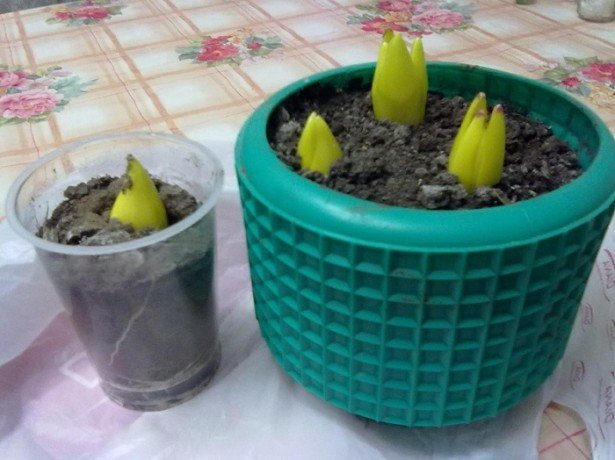

Photo of tulips in a pot
With the appearance of colored buds, it is recommended to rearrange the pot closer to the cold glass of the window, since at a lower temperature, the flowering period will stretch, and you will be able to admire the delightful flowering longer.
To extend the flowering period, it is also advisable to take out the pots with plants to the balcony at night, and during the day to spray the leaves with warm water (without getting on the flowers). The required air humidity level for tulips is about 80%. The soil should also be constantly slightly moistened.
Important subtleties:
- the bright sun should not shine on the flowers;
- protect plants from drafts;
- keep pots as far away from central heating radiators as possible;
- for irrigation, it is recommended to use settled water at room temperature;
- cut domestic tulips at the very surface of the earth, in the early morning before watering.
Video: how to get blooming tulips at home for the New Year
After home cultivation, the bulb is greatly depleted and it is no longer possible to reuse it for the same purpose, but you can plant it on the garden bed - the bulbs will recover in the open field, and they will bloom again the next year (but already in the flowerbed). Therefore, with the end of flowering, the buds break off and gradually reduce watering until the leaves turn yellow, then the bulbs are dug up, dried and stored at a temperature of +14 degrees in a dry basement.
The video attached to the article will allow you to better understand how to plant tulips at home. Following the recommendations, you will definitely be able to achieve excellent results and admire the exquisite buds on long winter evenings in anticipation of spring.
Tulip varieties for a New Year's or Christmas bouquet
From the group Simple early:
- Princess Irene - orange flower with purple stripes,
- Ruby Red - bright scarlet
- Flyer - bright red with yellow border,
- Yokohama is yellow.
Terry early ones are also suitable for forcing, for example yellow Monte Carlo, pink Peach Blossom and Stockholm, Abba and Electra reds, fringed red and gold Fringet Beauty.
Since tulips from this group are low (25-35 cm), it is better to drive them out not for a bouquet, but for interior decoration.
From the group Lily-colored:
- white White Trimfator, yellow West Point,
- bright red Red Shain,
- red with white border Aladdin,
- lilac with white border Ballad, pink Marietta, dark pink Jacqueline.
The plants in this group are 50-60 cm tall and are ideal for festive bouquets.
Varieties of the Kaufman group low, for distillation in pots and use in arrangement are recommended:
- Orange Boy (orange with a carmine-red back),
- Stresa (yellow with an orange-red back),
- Speranza (bright red).
- Peduncles of these plants are 15-25 cm, while the Speranza variety has only 10 cm.
Longlines and Sandwiches: Alternative Disembarks
A creative approach will make any business interesting. This also applies to floriculture. Recently, unusual methods of planting tulips are gaining popularity. They save time, decorate the garden and attract attention. In addition, they are quite simple and everyone can master them.
Container planting or basket planting simplifies the tulip growing process. The essence of this method is to use baskets, containers and other containers instead of a flower bed or garden bed. They can either be dug into the ground or freely positioned in any convenient place.
The advantages of this method:
- You firmly believe that you have completely dug up the planting material. The onions themselves are minimally traumatized and, therefore, better stored.
- You create optimal conditions for plant growth. Relevant for infertile soils - it is easier to create ideal conditions in a confined space.
- Reduces the likelihood of damage to bulbs by rodents. Mice cannot get past the obstacle from below.
Anything can be used as a container: plastic bottles, boxes, baskets, pots and even bags. One condition - you need to make holes for the outflow of excess water. Use a red-hot knitting needle or other similar object for this. The holes should not be large, otherwise mice will make their way through them.
The second way to arrange flowers in an unusual way is a tiered planting. The essence of this method is to lay the bulbs at different depths. The very first layer, starting from the bottom, is occupied by large bulbs. The higher the level, the smaller the size. In order not to make a mistake and not to plant one flower on top of another, use long thin sticks. Stick them next to the landing site, and after the flowerpot is completely filled, remove it. This combination method is also called "lasagna" - the structure resembles this dish in its layering.
It is important to take into account the color, size and shape of the petals when drawing up such a composition. Try to play on contrasts: smooth plant with terry, red with yellow.Groups of colors combined by color will look beautiful. For example, variegated with monochromatic: the color of the blotches should correspond to the mono color of the petals of the neighboring variety. A group in which tulips are selected according to the timing of flowering will look spectacular.
Video "Methods of planting tulips"
How to grow tulips from bulbs at home: cut features
Cutting flowers should be done before you watered the soil. The tulip is carefully cut at the root - near the bulb itself and placed in the water.
If you leave the flowers in the pot without cutting them, then after the petals turn yellow and dry, the bulb is dug out for storage.
A bulb from which a flower has already been grown at home cannot be re-planted in a pot. The fact is that during the growth of a plant in an artificially created environment, it is depleted, so it will no longer be able to give a full-fledged flower at home. But there is a dacha economy, perhaps next year in the spring tulips from such bulbs will give you buds.
Tulips are divinely beautiful and fragrant spring flowers that will decorate your home and give a wonderful mood to lovely women. Can tulips be grown at home? Certainly. Forcing tulips is not very difficult - even an amateur gardener can handle it. So try it more boldly, and get ready to enjoy bright colors, in truth, a gorgeous spring flower at any time of the year.
Many gardeners dream of growing tulips on their windowsill. That is why they ask themselves the question: "How to grow tulips from bulbs at home?" This is absolutely not difficult to do. The main thing is to be patient and strictly follow our recommendations.
How to grow tulips by March 8: good advice
Now we will give you practical advice on how to care for bulbous plants.
To germinate tulips at home:
- use water that has stood at room temperature for at least a day;
- feed with fertilizers;
- do not allow the penetration of sunlight on tulip sprouts and buds, because they can turn yellow and crumble;
- place flowers where there is no bright light, but, at the same time, there is good illumination;
- do not put the pots in drafts, because the plants get sick, like you and me, therefore, sudden changes in temperature are contraindicated for them;
- do not place flowers near the battery - you risk that the flower will not bloom at all.
How to grow large quantities of tulips for sale at home by March 8?
Some are so good at growing tulips at home that they are now planting flowers for sale. At the same time, there is an opportunity to get seedlings no worse than from a personal plot.
- boxes, at least 15 cm deep, or plastic containers;
- the soil;
- chilled onions.
A favorable time for planting is early September.
As you know, tulips germinate in the spring, as soon as the first snow begins to melt. In this case, the bulb undergoes temperature changes, and also depends on moisture. It is these factors in the spring that are the most favorable for the flower and contribute to its active growth.
It is not difficult to grow tulips for sale even in winter, the main thing is to observe the correct regime, from time to time rearranging the boxes from one environment to another.
The soil
Prepare the soil substrate:
- river sand (1 part);
- sod (2 parts);
- humus (part 1).
You can buy ready-made soil, for this order bags of soil in a flower shop. Selected boxes are ½ filled with prepared soil.
Making a drainage layer
To prevent water from stagnating, it is necessary to prepare a drainage layer. For these purposes, use:
Preparing the bulbs
First, take a good look at the planting material. Remove bulbs that show signs of rot and mold. Now soak them for about 30 minutes in a pale pink potassium permanganate solution.
Potassium permanganate disinfects the surface of the bulb, kills bacteria and prevents the occurrence of diseases in flowers.
Ground penetration
Planting material is placed in a box in rows - the bulbs should be 1 cm apart. Now the bulbs are embedded in the soil and sprinkled with earth to the top. Water abundantly. The earth shrinks.
As with growing in pots, the tulip should be 1/3 airborne. If, after watering, the ground subsided very much, then add more substrate - to the desired distance.
Where to put the boxes?
First, the boxes are placed in a dark, cool room, the temperature of which is 10 degrees. This makes it possible to create conditions close to the natural growing environment of tulips. Your bulbs will sprout quickly.
Plants should be watered from time to time.
The main thing is not to pour the flowers so that mold does not form on the ground. One watering per week is enough.
When buds appear, transfer the boxes with flowers to a cooler place again. For this purpose, you can choose cold window glass. It is the low temperatures that contribute to the fact that the buds will bloom much longer.
Tulips cannot tolerate dry air - in the natural environment they germinate at a humidity of 80%. Spraying with water, but so that it does not penetrate the buds (because of this, they can fade).
How to grow tulips by March 8: the right lighting
Flowers need to be accustomed to daylight gradually. For this purpose, the sprouts are first covered with a paper cap. The air temperature is also regulated by increasing it gradually.
If you immediately transfer the flowers to a room with room temperature, the stem of the flower will be thin, which will not allow the bud to gain all its power. In addition, a plant may develop a disease such as fusarium (damage to the leaves of a flower).
Poor illumination leads to lengthening of the tulip stem, and the color of the petals turns out to be too pale.
Selection and preparation of planting material bulbs
First of all, inspect the proposed planting material. All bulbs should be firm, dry, of approximately the same weight.... The surface should be free from damage, splits, rotted soft areas, mold stains and any darkened areas. The scales should completely cover the surface. Also, the bulb should not sprout. The approximate diameter of a good specimen is 3-4 cm.
Please note that it is very easy to injure the bulb and then it will not be possible to germinate it.because it will deteriorate. Therefore, transport carefully so as not to be damaged by accidental impact.
Important! Do not purchase bulbs with hardened scales. This means that they lay in the ground, now they will slowly germinate and not bloom soon.
What types and varieties of crops are there?
In order for tulip cultivation as a business to bring the expected result, it is important to choose the right variety. There are quite a few varieties today - about 3000. And sometimes it is not easy to make a choice, especially for a novice florist.
For convenience, all varieties are combined by flowering time into several groups:
- Early flowering. The buds bloom in the month of April. The most prominent representatives of this category are Candy Prinz and Shrenka varieties. Options with terry petals also look beautiful. These include Monte Carlo, Red Terry and Ice Cream.
- Medium flowering. If tulips are grown at home, they will delight with their beauty in the month of May. The flowering period is short, but it looks mesmerizing. The most popular varieties with simple flowers include Eric Hofsue, Dream Marias, Alexander Pushkin and Denmark.
- Late flowering. They dissolve at the end of May. Quite resistant to heat. However, they cannot stand late spring frosts. Therefore, in northern latitudes, this category of tulips is not used. But in the southern regions, Ballada and Prince Vladimir varieties are often planted. These are flowers with simple buds.Among terry items, Angelica and Double Beautyof Apeldoor deserve special attention.
If tulips are grown in a greenhouse all year round, beautiful flowering can be seen much earlier than April. This method is usually used by experienced flower growers, nursery specialists. A similar cultivation of tulips is called: distillation by a certain date. This flower is recognized as a symbol of femininity, spring. Therefore, it is often presented on the eighth of March. To grow a bouquet for this day, they do certain actions aimed at the earlier formation of buds. Read the article on perennial asters.
Login to the site
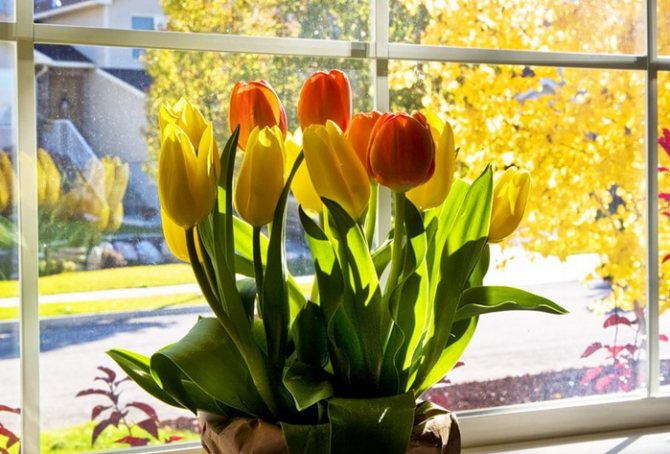

TULIPS ON THE WINDOWSILL Couldn't disperse the melancholy, Gloomy January fogs. And sadness falls on the line, But today I will not be sad! The touching news of spring, Stretching out the leaves hastily Tulips bloomed on the window, Brightly and divinely beautiful! Carried away the fogs and sorrow, Overwhelmed with a warm wave, And already February to me, not February. I breathe spring with full chest. Small, delicate flowers, And such changes in my soul, Dreams awaken again. Sunbeams on the walls, The sun came out from behind gray clouds! Breaking through the veil of fog. A timid ray looked through the window, On a date to the first tulip. AFANASIY FET Tulips suitable for home growing ↑
Not all tulips grow well at home. Of course, it would be very tempting to grow tulips of unusual colors on the windowsill - brown, blue, purple, black, etc. However, exotic varieties are quite capricious, so for home cultivation it is better to use proven varieties: Aristocrat, Christmas Marvel, Oxford, Epricot Beauty, Parade, Fringit Elegance, Diamond Star, Diplomat, Lustige Battle, Bridge Miles, Negrita, Confux, London, Temple of Beauty , Apeldoorn, Eric Hofsier, Scarborough. Even novice flower growers can cope with the cultivation of such an unpretentious variety as Parade Record (Darwin hybrids).
When choosing tulips for growing at home, it is worth giving preference to low-growing varieties that are resistant to diseases (especially variegated leaves), unpretentiousness to growing conditions and are able to tolerate minor disturbances during care. Purchased planting material is already completely ready for forcing - the bulbs are sorted and processed, so they can be planted immediately. If you decide to independently prepare planting material from tulips growing in the garden, you will need to provide them with thorough care throughout the growing season: feed, water, loosen the ground and destroy weeds. In this case, you need to dig up the plants as soon as the stems of the tulips begin to turn yellow.
Select the largest of the bulbs dug out and send them to dry in a dry room. In this case, the following temperature regime must be maintained: the first week + 34 ° С, then two months + 23 ° С, and the last month + 17 ° С. After that, the planting material must be placed for cooling in a box or gauze bag on the lower shelf of the refrigerator (or in the basement), where it is stored until planting at a temperature of +5 ° C.
Planting tulips at home - step by step instructions ↑
Growing tulips at home is based on forcing technology: artificially created conditions for plants are similar to natural ones. At the same time, special attention is paid to cooling the bulbs, because in nature they form shoots and flowers only after they have passed the stage of winter rest. Another thing is that the technology of distillation by controlling the temperature regime allows you to get fresh flowers in the middle of winter or early spring - at the request of flower growers.
So, the bulbs are ready for planting, it's time to figure out how to plant tulips at home:
you can start planting at the end of September; prepare pots or bowls at least 15 cm deep; mix the substrate from the river stove, sod land and humus (1: 2: 1), add a little wood ash to the substrate, or buy a ready-made soil mixture with good water permeability and a neutral reaction; Before planting, inspect the bulbs from all sides for diseases and immerse them in a potassium permanganate solution for half an hour; put drainage in bowls or pots for tulips (you can use sphagnum moss) and fill the container with a substrate so that the distance to the edge remains three times more than the height of one bulb; spread the planting material on top of the ground, bottom down, one centimeter apart; fill the onions with the substrate to the tops; water and top up the soil mixture if the tops of the bulbs appear from under the ground; transfer the pots with plantings to a dark room where the humidity is 80%, and the temperature is not higher than + 9 ° C. Planting should not be left unattended - make sure that the earth does not dry out, but also does not mold. Weekly watering will be sufficient.
How to achieve and prolong tulip bloom ↑
After a few weeks, you will notice that the potted bulbs are sprouting. As soon as the seedlings reach a height of 6-7 cm, it's time to transfer them to the room and gradually accustom them to daylight, at first covering them with a paper cap. It is desirable that the temperature also rise gradually, within two to three days, up to +18 ° C. At a higher temperature, tulips at home will form weak, thin peduncles, possibly even damage to plants by Fusarium.
If you are growing your tulips at home in winter, provide them with artificial light for ten hours, otherwise the stems will be very elongated, and the color of the flowers will be pale. With the appearance of colored buds, it is recommended to rearrange the tulip pot closer to the cold glass of the window, since at a lower temperature, the flowering period will stretch, and you will be able to admire the delightful flowering of tulips for a longer time.
To extend the flowering period, it is also advisable to take out the pots with tulips to the balcony at night, and spray the leaves with warm water during the day (without getting on the flowers). The required air humidity level for tulips is about 80%. The soil should also be constantly slightly moistened.
Important subtleties:
the bright sun should not shine on tulips; protect plants from drafts; keep flower pots as far away from central heating radiators as possible; for irrigation, it is recommended to use settled water at room temperature; cut domestic tulips at the very surface of the earth, in the early morning before watering. After home cultivation, the bulb is greatly depleted and it is no longer possible to reuse it for the same purpose, but you can plant it on the garden bed - the bulbs will recover in the open field, and the next year the tulips will bloom again (but already in the flowerbed). Therefore, with the end of flowering, the buds of domestic tulips are broken off and watering is gradually reduced until the leaves turn yellow, then the bulbs are dug up, dried and stored at a temperature of +14 degrees in a dry basement.
How to care?
Pots or containers should be placed in a bright place, but not in direct sunlight or under a radiator. Perhaps it will be a table near the window. Drafts should also be avoided.
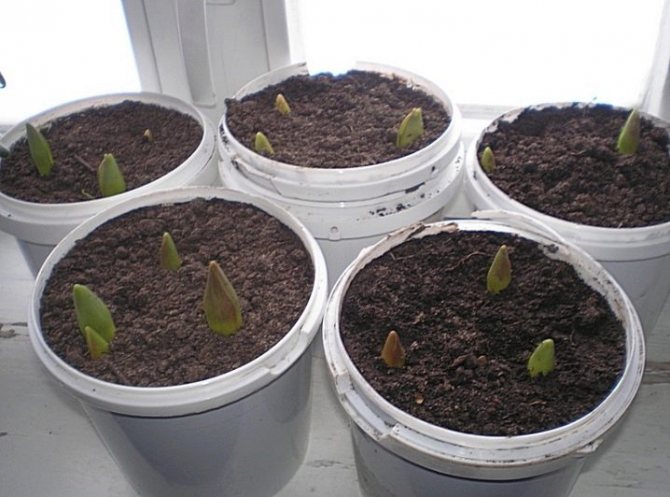

Watering
Flowers should be watered about 2 times a week. The earth should not dry out, but it is definitely not worth pouring the plant. Leaves can be sprayed with water in dry rooms.
Top dressing
For better and faster growth of the flower and its protection from bacteria, it is better to use a special dressing for tulips, which are sold in large quantities in specialized flower shops. One feeding will be enough.
Features of the
In order to grow tulips at home in a pot in winter, you need to familiarize yourself with some of their features.First of all, this is the planting time, which largely depends on the variety of the given plant and indicates whether it is early or later. In addition, it is very important to know which planting material is used: germinated or not. For planting in a pot, a bulb with a weight of at least 25 grams should be used so that it has enough nutrients.
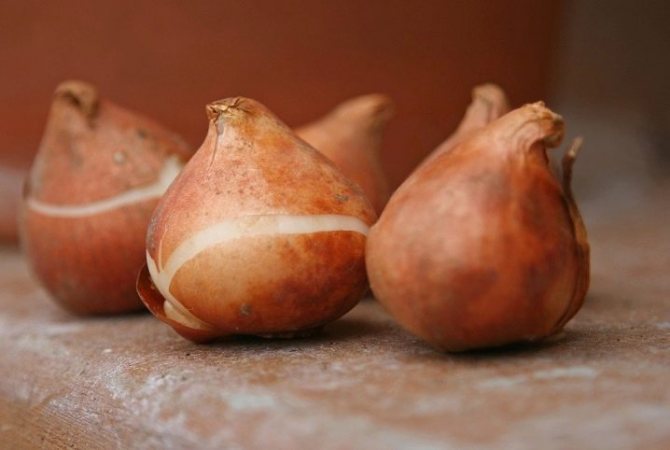

There are several distillation options.
- Early. Tulips bloom during the New Year holidays, respectively, the end of December and the beginning of January. At this time, tulips will become a truly fabulous gift.
- Medium early. Plants bloom in January just in time for Christmas.
- Middle. The blooming of tulips begins in February and pleases all lovers with the beauty.
- Late. The very last of the options, which is great as a gift for March 8th. Probably, there is no such person on earth who would not want to please his loved ones or mothers with such beauty, and even grown by his own hands.


Testimonials
Summarizing the reviews of florists, we can conclude that growing tulips in pots at home is quite feasible if you follow the instructions. Tulip bulbs can be awakened to life and bloom at any time you need.
Observing a strictly defined temperature regime, you can plan the appearance of beautiful flowers at home for the spring holidays and even for the New Year, to please yourself and your loved ones with beauty.
By learning how to grow tulips at home using the example of several pots, you can expand the volume and grow them in boxes for sale, while making a good profit, especially during the winter season.
Variety selection
Sooner or later, every lover of flowering plants has a question about how to grow tulips in a pot. They are quite unpretentious flowers, so even a beginner can cope with this task. And growing flowers with your own hands by March 8 in a pot will be doubly pleasant. Let's make a reservation right away that this article will focus exclusively on growing tulips from bulbs.
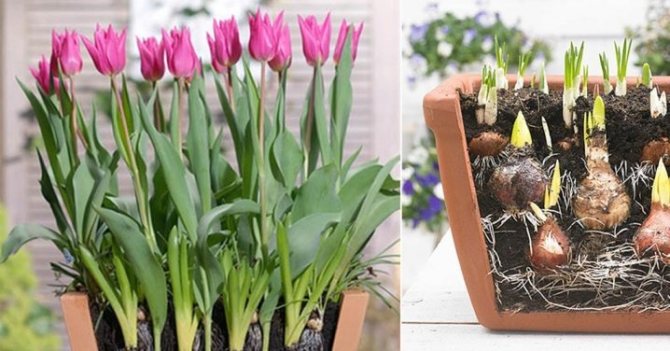

So, if you decide to start growing this flower at home, then you should remember that not all varieties are suitable for this task. Different varieties and types are adapted to different conditions. Low-growing varieties are best suited. Tall tulips are more difficult to grow, and they are more susceptible to various diseases. The most suitable varieties are: "Parade", "London", "Oxford", "Aristocrat", "Lustige Vitve". This is the most popular and unpretentious five. The varieties are listed in order from most popular to less popular.
How to properly plant tulips in the fall in open ground
You can plant tulips in different ways, each of which has its own adherents.
The classic way
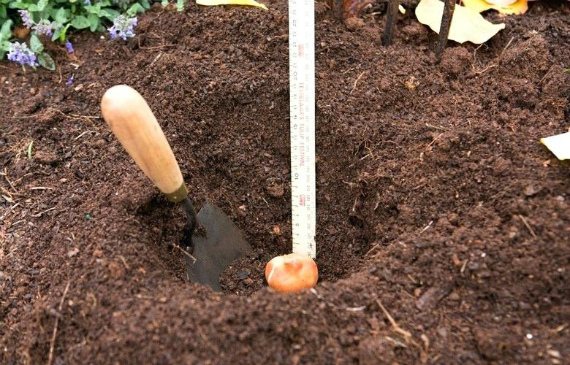

In traditional planting, tulips are planted in separate holes at a distance of 15-20 cm from each other. Then each plant will be able to develop freely without disturbing its neighbors. To obtain a lush flowering, a denser planting is chosen with an interval of 8-10 cm between the bulbs. In this case, the plants need ideal conditions for normal development: fertilized soil, good lighting, proper care.
The bulbs are pre-sorted by size:
- small specimens are planted to a depth of 6-8 cm separately;
- for large, a depth of 10-12 cm is suitable.
Gardeners have adopted the following rule for planting bulbous flowers: the larger the planting material, the deeper it is planted. Planting depth should be approximately three times the height of the bulbs.
On a note! Small bulbs must be planted on the south side of the flower bed, so that in the future the tulips are not shaded by taller neighbors.
Planting in baskets (containers)
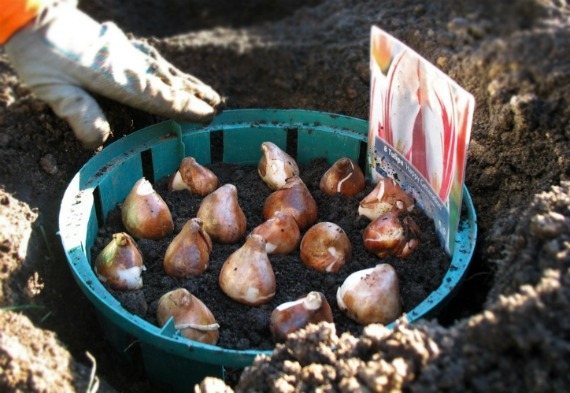

Today, gardening stores sell special plastic baskets for planting bulbous flowers. The containers can be rectangular or round, they have sides 10-12 cm high.Planting in such containers is very convenient for the gardener:
- Bulbs will not be confused by varieties.
- The basket can be filled with bulbs in advance, and then spend very little time planting all the tulips at the same time.
- If there are mice in the area, the plastic material will make it difficult for them to access the bulbs and the tulips will remain intact.
- When digging for the next year, the onions will definitely not be lost, because they, together with the children, will still be in the same basket.
To remove the bulbs from the ground, it is enough to slightly pry the container from below with a pitchfork and pull it to the surface. Considering all the listed advantages and the low price of plastic containers, this method of planting seems to be more profitable and convenient in comparison with traditional technology.
Longline landing
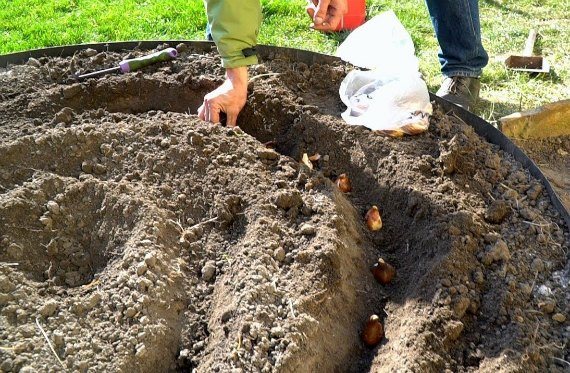

A tiered planting of bulbous flowers is also called a "sandwich" because the bulbs are arranged in layers. A variety of primroses are planted in one hole. It can be:
The bulbs of those varieties that are combined in color shade are pre-selected. Plants can bloom at the same time or bloom one after the other.
Planting depth depends on the size of the bulbs. Large tulip bulbs are placed in the lowest layer, hyacinths are planted above them, the uppermost layer may consist of crocuses. So that in the future the plants do not interfere with each other, the bulbs are placed on the flower bed in a checkerboard pattern. Such a composition can revive the most boring corner of the garden, settling on it with a juicy spot.
How to grow tulips at home by March 8: planting and care stages
Preparing the soil
Either pure peat or diluted with sand should be taken as a basis. A good option is perlite or regular garden soil. In addition, it is imperative to use compost or manure in equal proportion to the soil. Add some wood shavings, stir.
Planting bulbs
How to grow tulips from bulbs at home? - the question is not difficult, but scrupulous. Their planting should be carried out at a distance of 1 cm from one another, while 1/3 of the plant head should protrude above the ground.
After you have done the introduction of the bulbs into the soil, pour plenty of water over them.
What else is watered on the bulbs when planting?
The best watering option for newly planted bulbs is a specially prepared solution. To do this, take: - 5 liters of water; - 10 g of calcium nitrate (0.2%).
If, after such replenishment with a solution, the earth shrinks strongly, you need to add more soil. Remember, the bulb should be 2/3 in it.
We observe the temperature regime
Freshly planted plants should be taken to a room where the air temperature reaches +10 degrees (not more than a degree). For example, you can choose a basement or a corner of the conservatory.
How to grow tulips on a windowsill? - the final stage
As soon as your bulbs have sprouted, which have reached a height of 5 cm, you can safely put the tulips on the windowsill. The flowers will now feed on sunlight.
Is it possible to grow tulips in an apartment - caring for home flowers
If you want to contemplate fresh spring flowers in winter, then you should pay special attention to seedlings:
- Seedlings need to be watered regularly: 2 times a week. Be sure to ensure that the soil is not dry.
- Make up the flowers every 2 weeks. To do this, purchase a special product at a flower shop and dilute it according to the instructions on the package.
- As soon as the flower throws out the buds, make sure that they do not fade ahead of time. To do this, move the pot away from a radiator or heater, as the hot air speeds up the flowering of tulips.
Varieties
Today, a large number of tulip bulbs are presented on the markets, which have different forcing dates. Among them, the following varieties are worth noting.
- Plants with early forcing. This is, first of all, "Diamond Star" or "Miz Bridge".The buds appear in 2.5 - 3.5 months. The height of such tulips is small, up to 35 centimeters, and the buds in a circle do not exceed 7 centimeters. Most often, in their shape, they resemble a glass. Great for beginner gardeners.
- Medium distillation tulips. Most often these are "Darwin's hybrids", which attract many with a high bud reaching 11 centimeters. In addition, the plant itself grows up to 75 centimeters. However, for novice gardeners, growing them is not an easy task. It will be difficult to cope with their forcing without the tips of more experienced comrades, since the bud is too heavy and it will be very difficult to keep it for a long time.
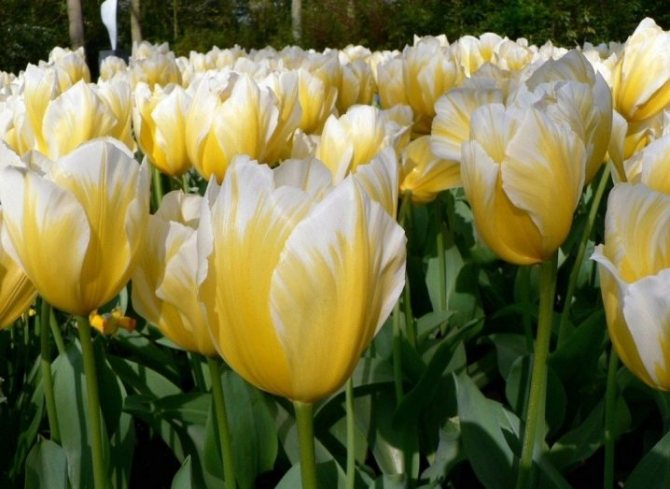

- Late varieties. For example, "Aristocrat" or "Triumph". Their height is also no less than 75 centimeters, but the height of the flower is slightly lower, up to 9 centimeters. The shape of the bud is more like an open bowl.
The right time
So when is the best time to plant flowers in a pot? It is important to observe the cycle of plant growth and development and plant them in the same period when they are planted in the ground - in September. This is suitable for bulbs that you have dug up from the soil. If purchased material is used, then you can plant in a pot with the onset of cold weather. Thus, you can get flowers for the holiday of lovers or by March 8, it all depends on the variety and growing conditions.
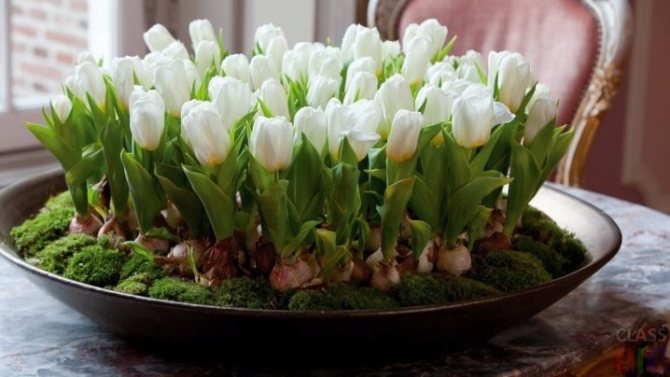

Characteristics of tulips flowers
Before we consider the technology of growing tulips in the open field and in an apartment, it makes sense to give a description of a popular flower. This plant can often be found in summer cottages. It is planted in flower beds, grown for cutting. Moreover, the culture is capable of growing even in cold regions, the main thing is to choose a suitable variety and comply with the planting dates.
What a tulip looks like in the ground is described below:
- Height varies from 10 centimeters to one meter.
- The root zone is represented by adventitious roots that grow from the bottom of the bulb.
- The stem is erect, cylindrical.
- The foliage is painted in a bluish-green tone. There is a slight waxy coating. The shape of the leaf plate is elongated-lanceolate. The leaves are arranged on the stem alternately. The lower leaflet is the largest. And towards the top, the size decreases.
- There is usually only one flower. True, many-flowered varieties are also known, on which about 3-5 buds are formed. The inflorescences are correct. The perianth consists of six petals. There are six stamens, they have elongated anthers. Usually the classic tulip is red. Although there are white and yellow tulips in the country. As for varietal flowers, here the tint palette is wider. For example, there are purple, violet, black and pure white specimens. There are known varieties that combine several colors. The shape is also different. More often it is goblet, cupped, oval, star-shaped, lily-shaped, peony-shaped and fringed. The size varies from variety. There are buds that, when opened, reach 12-20 centimeters. And there are varieties of tulips, the flower diameter of which does not exceed 3 centimeters. Inflorescences open in the sun and close again with the onset of evening. In cloudy weather, they are closed.
- The fruit is a triangular box. It contains flat or triangular seeds of a brownish-yellow tone.
Preparatory work for forcing bulbs
Winter cultivation of tulips consists in the use of forcing technology.
In the process of basic work, the gardener must bring the temperature and humidity of the air, as well as lighting, as close as possible to natural conditions.
The main work on growing tulips at home is carried out in the following sequence:
- Planting of bulbs takes place in the last decade of September.
- For growing flowers, flowerpots are chosen up to 15 centimeters in depth.
- You can buy potting soil or make your own. It consists of one part of humus and river sand and two parts of sod land.To enrich the earth with microelements, a little wood ash is introduced into its composition.
- We examine the bulbs for the presence of diseases, lower the planting material for 30 minutes in a solution of potassium permanganate for disinfection.
- We put the drainage in pots, fill them with a nutrient mixture.
- We spread the bulbs on the soil surface, maintaining a distance of 1 centimeter.
- We fill the planting material with soil.
- We water the soil.
- Move the pots to a dark, but damp and cool room. The temperature in this place should not exceed +9 degrees, the humidity is within 80%.
Further care of flowers consists in additional watering. The soil must be moistened at least 1 time per week.
Diseases and pests
The most dangerous mushrooms for tulips are mushrooms. They penetrate the flower bulb itself and destroy it. The cause of the appearance of fungal diseases is high humidity. It is possible to dry the bulb incorrectly without observing the temperature regime, then it will already initially be sick. Or you can plant an onion and take care of it incorrectly, then inflammatory processes will begin to appear in the ground.
Due to the fungus, the flower becomes weak, lethargic, may release an arrow and not bloom. The most dangerous fungal infections are gray rot, white rot, typhulosis, root rot, fusarium.
Some types of rot can be fought, but if others are found, it is unlikely that it will be possible to help the plant.


Viral diseases are also dangerous for flowers. Unfortunately, there is currently no cure for viral infections such as variegation and August disease. In the case of variegation, spots and stripes on the petals are observed. Previously, it was believed that this is a new variety of tulips and gardeners even tried to breed such flowers in large numbers, however, today it is reliably known that petals affected by the virus acquire a different color. It can be brought in by birds, insects, including those living in the ground, and even by the person himself when cutting a flower (in the event that, for example, if the juice from a sick tulip gets on the stem or petals of a healthy one).
August disease manifests itself in the form of an ugly curvature of the stem, flower leaves. The virus affects the growth and development of tulips. The bulb itself can be affected (rotting will be visible on it), as well as the stems and leaves (light spots will be visible on them). This virus is transmitted from the weeds on which it constantly lives. Unfortunately, the affected bulbs cannot be cured and must be destroyed.
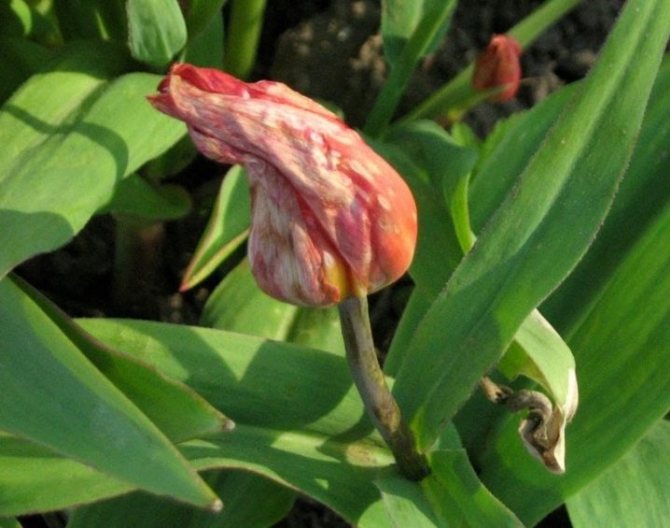

It is important to use high-quality soil and bulbs when planting and, in case of doubt, correctly determine what exactly the bulb is affected by in order to prevent the further spread of the disease of flowers in the pot.
Bacteria and microorganisms, as well as insects that live in the ground, are no less dangerous for tulips. Depending on what symptoms the tulip has, appropriate treatment is undertaken. This can be either spraying or watering the plant with the necessary solutions.... The addition of ash, magnesium, sodium may also be needed.
The disease weakens the flowers, disrupts the cycle of his life. Even by releasing the arrow, the tulip may not bloom. If the flower grew strong, and yellowness began to appear on the leaves, pay attention to whether you have changed the location of the plant, whether it is standing in a draft. Be sure to check if the flower has enough sunlight, if the lighting is normal for it. This is the first reason for yellow and weak leaves, provided that the tulip has grown strong and healthy before.
It is important to establish the cause of the disease as early as possible and eliminate it. Otherwise, the flowering of these beautiful flowers can not wait. Indoor flowers feel when they are lovingly grown, when they are properly cared for. They will gratefully respond to your efforts with beautiful, fresh, bright and large flowers.
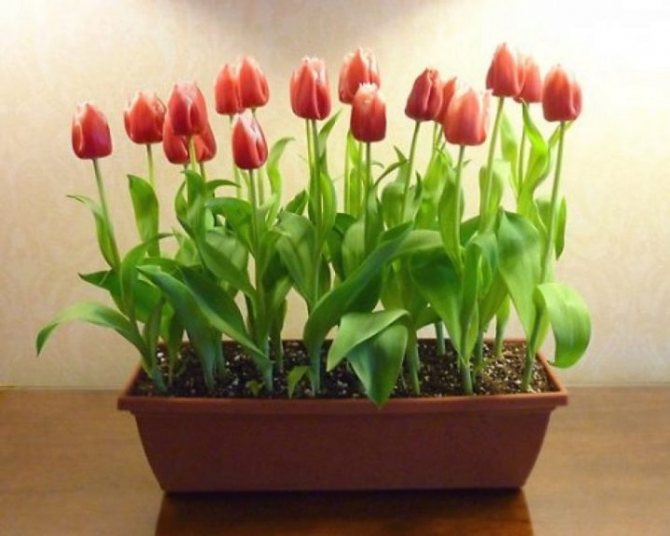

For information on how to grow tulips at home by March 8, see the next video.
Tulips are very beautiful and delicate flowers, the aroma of which envelops you in a languor of bliss and gives you real spring warmth.
To date, breeders have bred many of their varieties. Among them:
- terry;
- green-flowered;
- Rembrandt tulips;
- Kaufman tulips;
- parrot;
- and many others.
We associate tulips with a country like Holland. But the flower itself is from Asia. Its name is consonant with the word "turban", which means a headdress (it is, the tulip bud really resembles a turban).
Holland is the leader in the number of tulips produced per year. There are many festivals dedicated to this flower.
Flowers sprout from bulbs, belong to the lily family. Under natural conditions, tulips grow in early or late May. But you want to contemplate such handsome men all year round, especially on March 8th. That is why people who want to have spring flowers in their winter garden are interested in whether it is possible to grow tulips at home?
Growing
After planting, the pots with future tulips should be placed in a cooler place. The temperature in it should be within 5 degrees above zero, and the humidity should be at least 70 percent. If there is a basement or cellar, then they are the best fit. However, if there are no such premises and the person lives in an apartment, then disembarkation on the balcony will do. You can also put the pot in the refrigerator, using the bottom shelf where the temperature is most suitable. In addition, the pot must be covered with either thick cardboard or, in extreme cases, with an ordinary newspaper, but leave a small hole so that the bulbs can breathe.
After a month and a half, a flowerpot with bulbs can be taken out and transferred to a warmer and darker place, where the temperature should be within 13 degrees. If this is an apartment, then you can put it on a windowsill, where there is no battery, or near the balcony, at the very bottom, near the door. In the event that this is not possible, you can put the pot near the window, but at the same time covering it. From time to time, the bulbs need to be watered so that they do not dry out.
Read also Hosta sharmon hosta sharmon
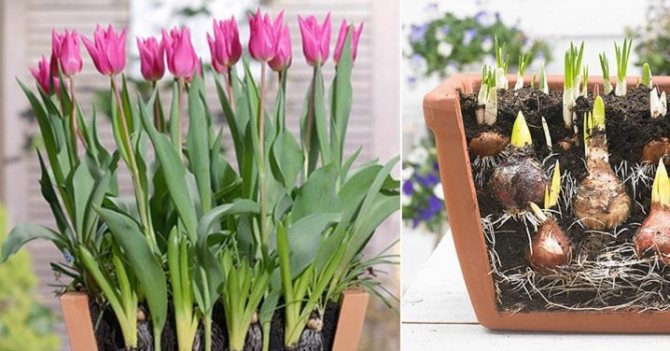

After one week, you can see that the bulbs have sprouted up to 6-8 centimeters. Now you can remove the cardboard and continue growing in a warmer and lighter place, for example, on a window. However, the light should be diffused, and the sun's rays should not burn young shoots. Therefore, it is best to use windows that face west or east. The temperature must be maintained within 18-20 degrees.
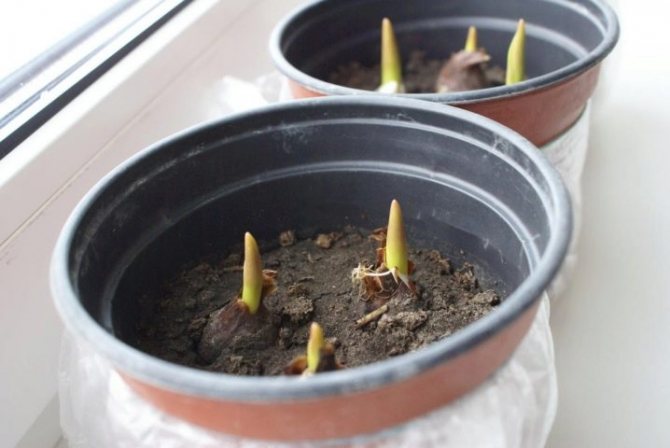

After a certain time, the leaves of the tulips will acquire a natural green color. In addition, you will be able to see how the first buds are formed. This means that soon they will delight their owners with flowering. If the buds appear too early, then for a while they must be placed in a cool place. This will not only slow down the onset of flowering, but it will also extend it by a few days.
